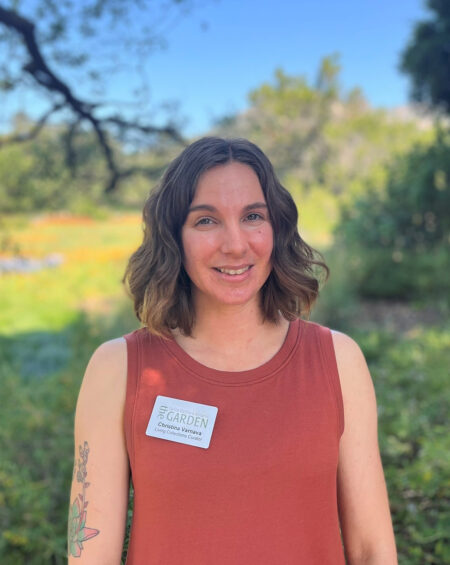Native Plant Introductions
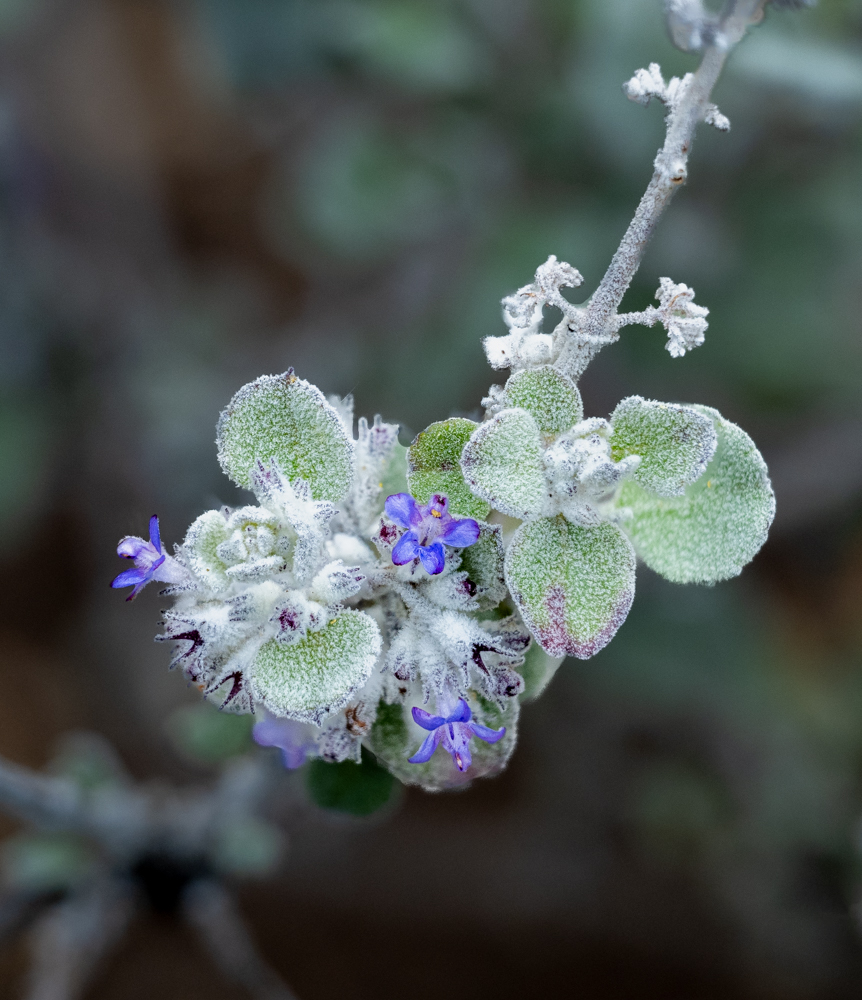
Growing the Trade
Making Native Plants More Accessible
Santa Barbara Botanic Garden has a long history of creating, selecting, and evaluating cultivars of native plants. Beginning in the 1950s with the Garden’s first on-staff horticulturist and plant breeder, Dara E. Emery, we’ve introduced over 30 native plant cultivars to the horticultural trade. This rigorous selection process continues today as we strive to develop and promote new plants. To be a candidate for introduction, plants must be tested in a variety of environments and they must be relatively easy to propagate and cultivate.
Native plant cultivars are important to our history and contribute to California’s native plant nursery trade. Through the Garden’s Plant Introduction program, we encourage everyone to grow native plants by offering beautiful, hardy, and climate-adapted options perfectly suited for California gardens.
Our Plant Introduction Collection
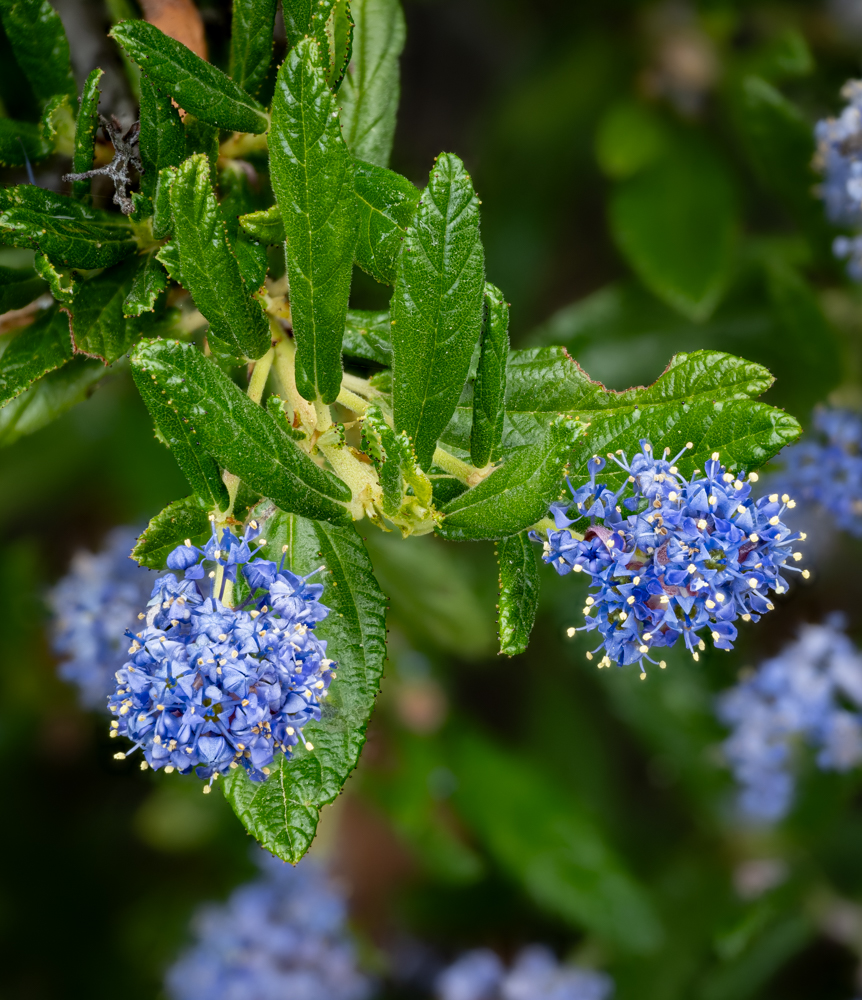
Wheeler Canyon mountain lilac (Ceanothus ‘Wheeler Canyon’) is a dense, mounding, evergreen shrub with copious clusters of dark-blue flowers and glossy green leaves. The burgundy-colored buds add extra interest even before the flowers open. Wheeler Canyon mountain lilac is highly ornamental in both coastal and inland locations.
It was originally propagated from cuttings of plants found roadside in Wheeler Gorge by Santa Barbara Botanic Garden’s first horticulturist and plant breeder, Dara E. Emery. (Photo: Greg Trainor)
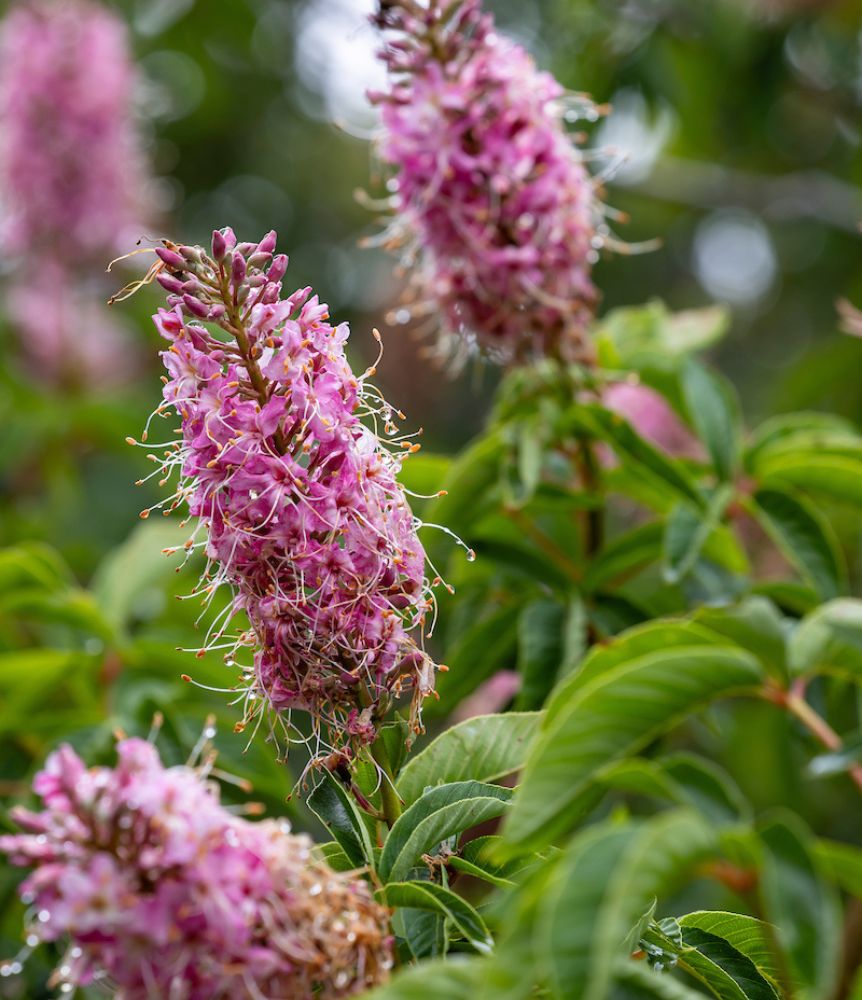
Canyon Pink California buckeye (Aesculus californica ‘Canyon Pink’) is a medium-sized, deciduous tree featuring fragrant clusters of light pink flowers that appear in late spring. This tree tolerates summer drought well, and it generally loses its leaves for the year in late summer or early fall, with new leaves emerging in late winter. Large, tan seedpods add seasonal interest in late summer and fall when the branches are bare.
This cultivar originates from a seedling selection made by Santa Barbara Botanic Garden’s first horticulturist and plant breeder, Dara E. Emery, from a batch of California buckeye seed collected by Dr. Robert F. Hoover in Monterey County. (Photo: Saxon Holt)
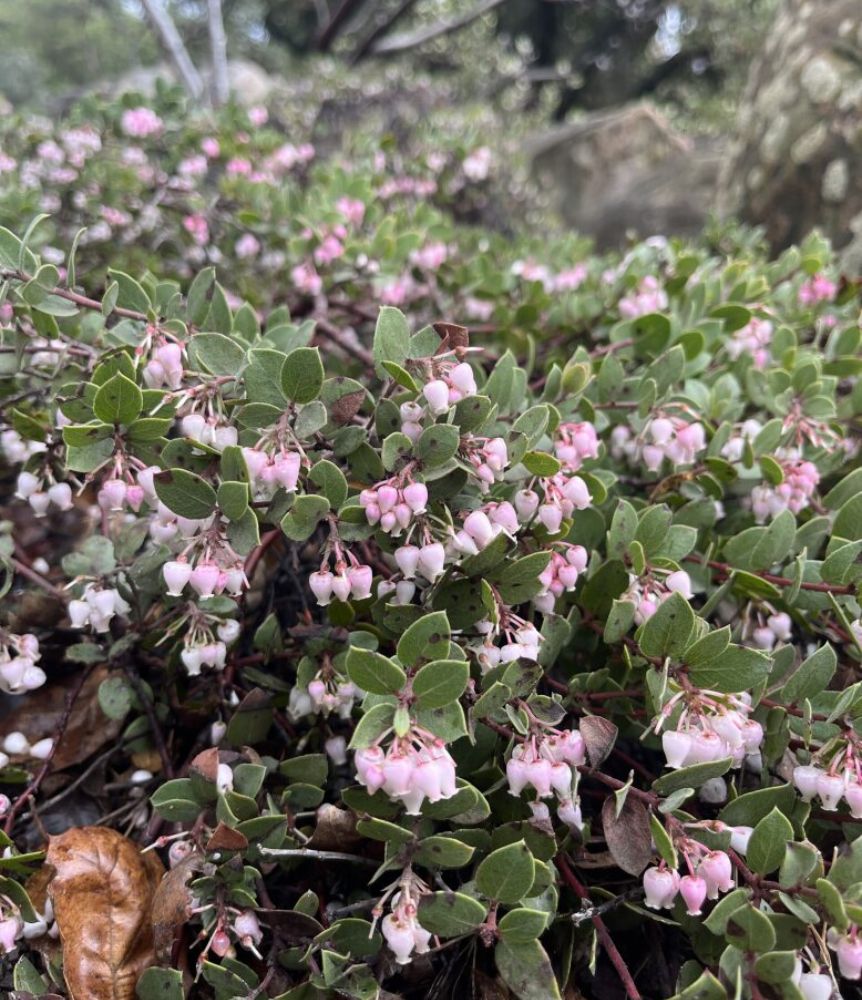
Arroyo Cascade manzanita (Arctostaphylos ‘Arroyo Cascade’) is a drought-tolerant, evergreen shrub and an ideal ground cover. Plants slowly spread 6 to 9 feet (almost 2 to 3 meters) wide and remain close to the ground. Leaves are slightly gray-green and contrast nicely with the visible dark red stems. Rosy pink blossoms appear in winter. (Photo: Christina Varnava)
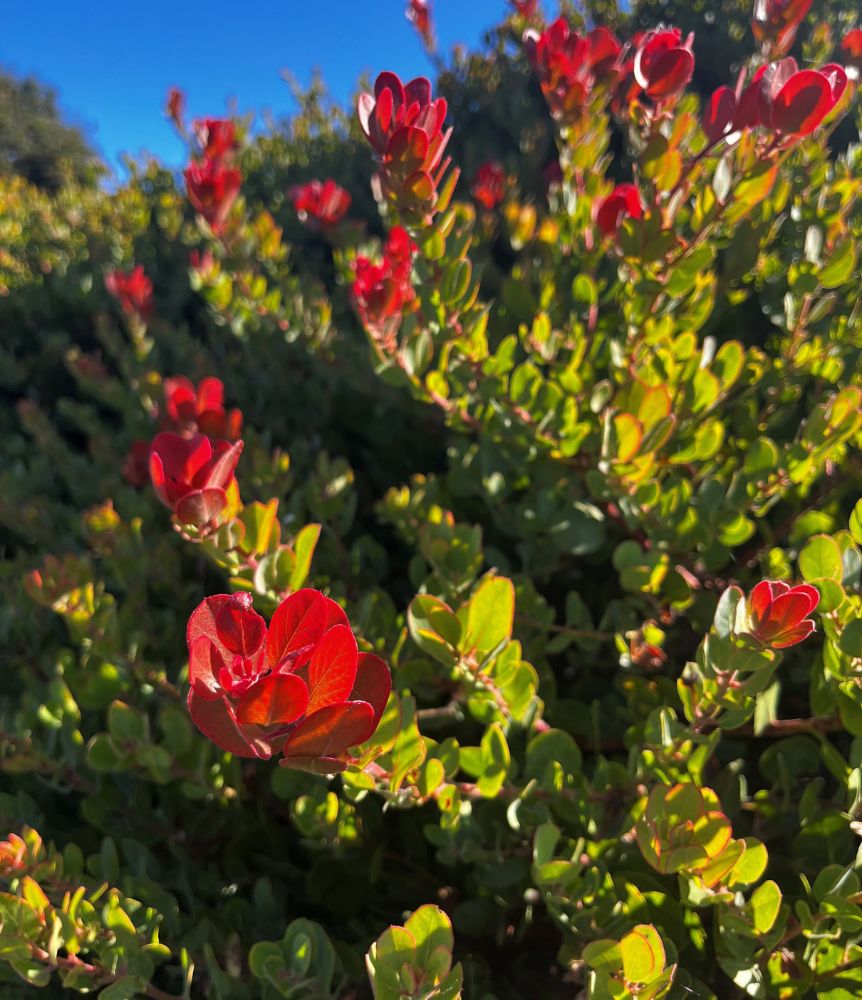
A massive evergreen shrub, Canyon Blush manzanita (Arctostaphylos glauca x glandulosa ‘Canyon Blush’) is a beautiful manzanita. Light pink flowers appear in winter, followed by a decorative crop of little apple-like fruits. Its name refers to both the red-flushed new foliage and the blush of pink in the flowers, which fade to white as they age. Older leaves have a faintly bluish cast.
This cultivar originated from a chance seedling at Santa Barbara Botanic Garden, selected by Santa Barbara Botanic Garden’s first horticulturist and plant breeder, Dara E. Emery. (Photo: Christina Varnava)
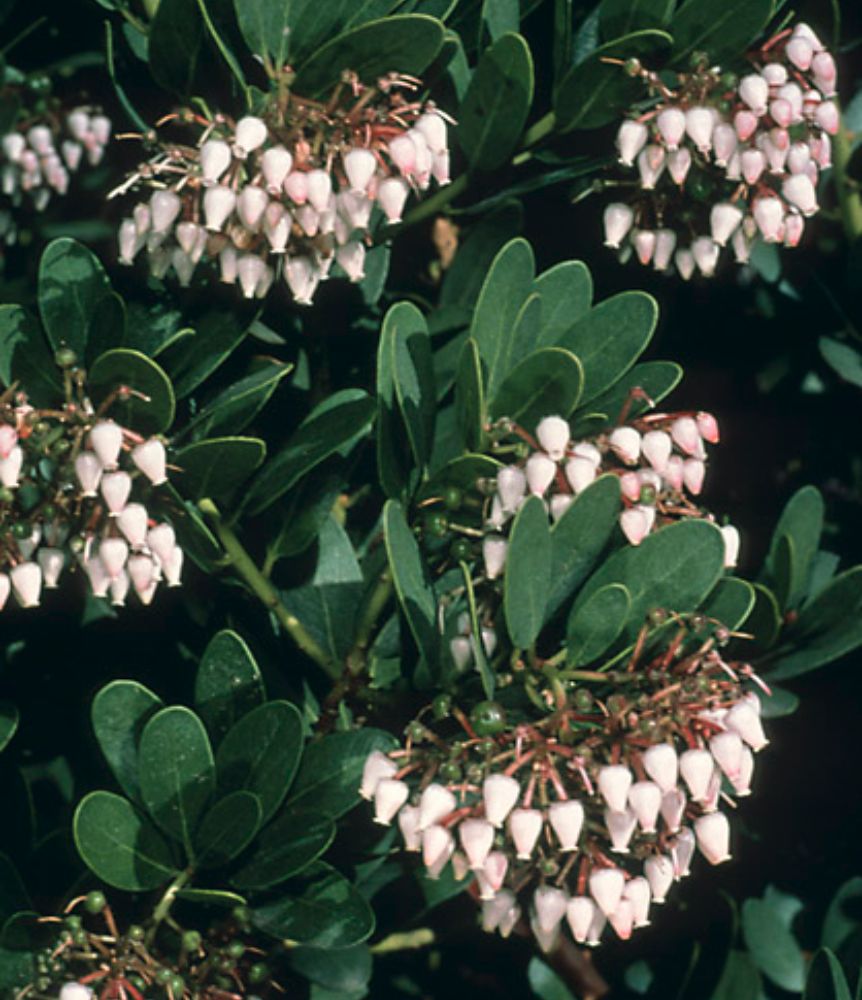
An evergreen shrub with one or two main trunks, Canyon Sparkles manzanita (Arctostaphylos insularis ‘Canyon Sparkles’) is distinguished by its large, dense clusters of white flowers in winter. Its elliptic, medium-green leaves are glossy when young. Annually, the outer reddish-colored layers of bark slowly exfoliate and reveal a creamy inner bark that will eventually deepen in color.
This cultivar is a selection made by Santa Barbara Botanic Garden’s first horticulturist and plant breeder, Dara E. Emery, from seeds collected on Santa Cruz Island. (Photo: Steve Junak)
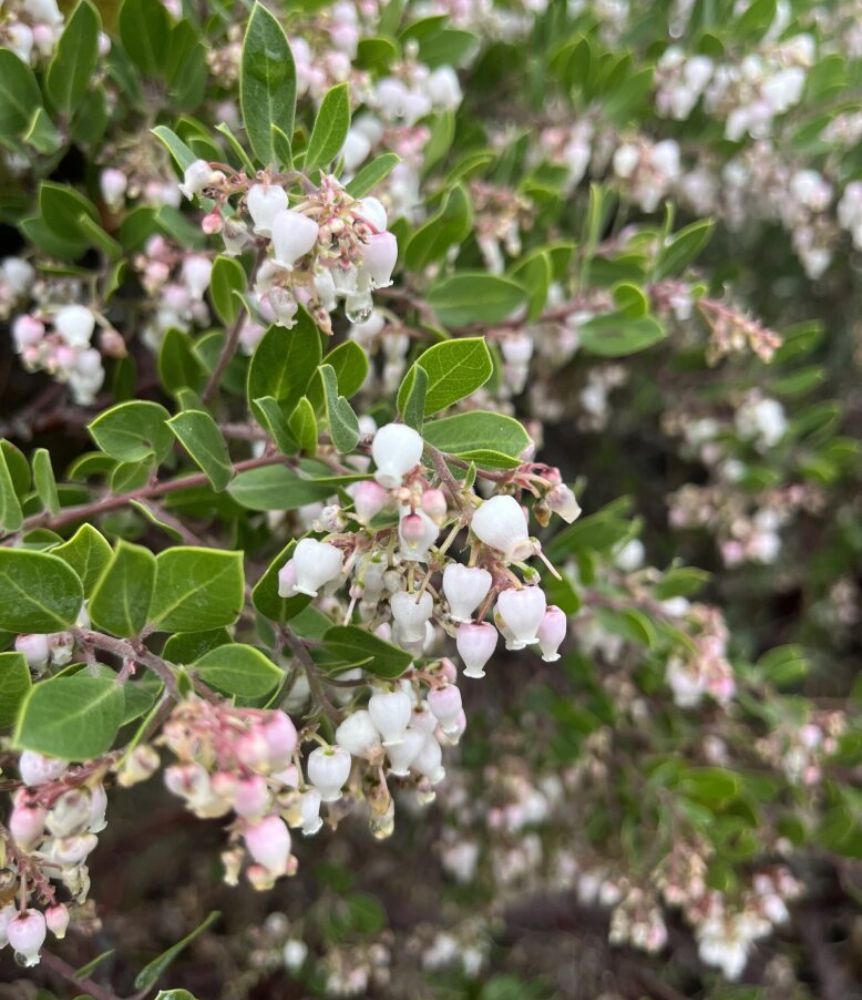
A very dense evergreen shrub, White Lanterns manzanita (Arctostaphylos ‘White Lanterns’) slowly matures to 5 to 7 feet (1.5 to 2 meters) tall by 8 to 12 feet (2 to 3.5 meters) wide. Drifts of white flowers tinged with pink appear in the winter, contrasting well with the dark mahogany bark. The small oval-shaped leaves are medium-green in color.
This cultivar originated from a chance seedling at Santa Barbara Botanic Garden, selected by the Garden’s first horticulturist and plant breeder, Dara E. Emery. (Photo: Christina Varnava)
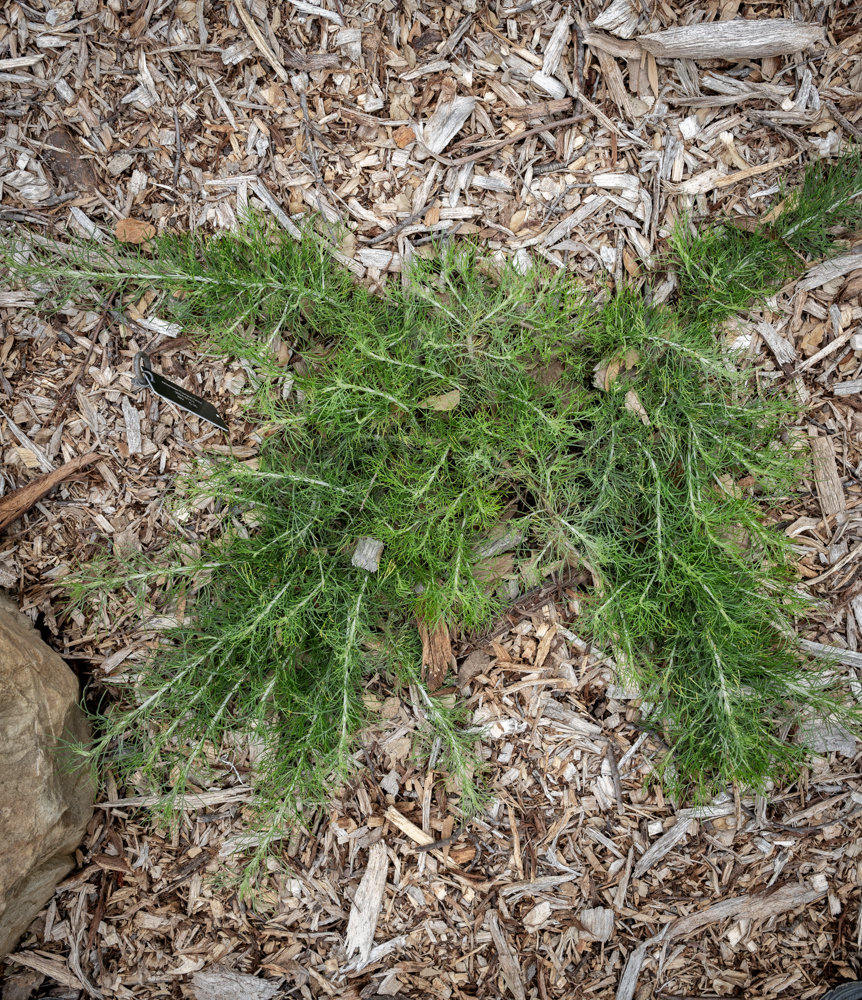
Canyon Gray sagebrush (Artemisia californica ‘Canyon Gray’) is a large-scale groundcover. A dense, semi-evergreen shrub, it spreads to 10 feet (3 meters) or more, yet remains about 2 feet (about .5 meters) tall. Its fine-textured, silver-gray foliage is highly aromatic when crushed. Flowers are fairly inconspicuous.
This prostrate form of California sagebrush was found growing in a windswept area on San Miguel Island by former Santa Barbara Botanic Garden Director Ralph Philbrick, Ph.D. (Photo: Greg Trainor)
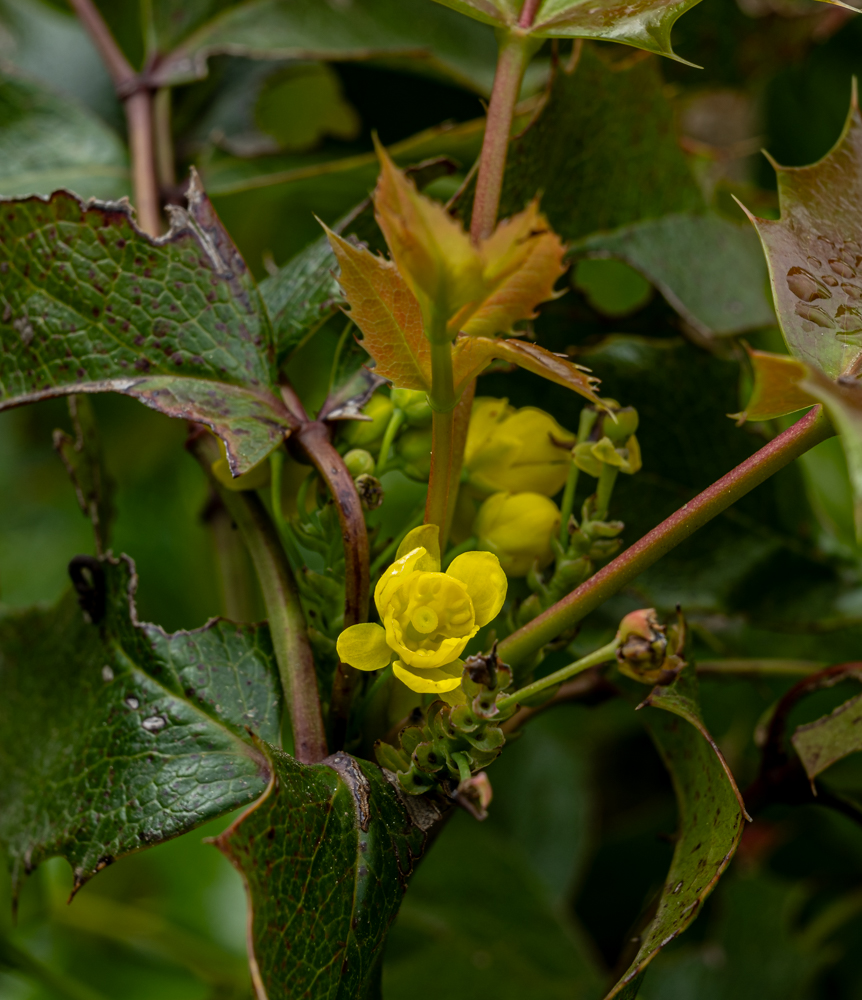
Mission Canyon Oregon grape (Berberis aquifolium ‘Mission Canyon’) is a spreading evergreen shrub with glossy green, spiny foliage. The bright yellow flowers in spring are followed by dark-blue-colored berries that attract birds. This tough and durable shade-tolerant shrub is reliable and easy to grow, and it was originally selected by Santa Barbara Botanic Garden’s first horticulturist and plant breeder, Dara E. Emery. (Photo: Greg Trainor)
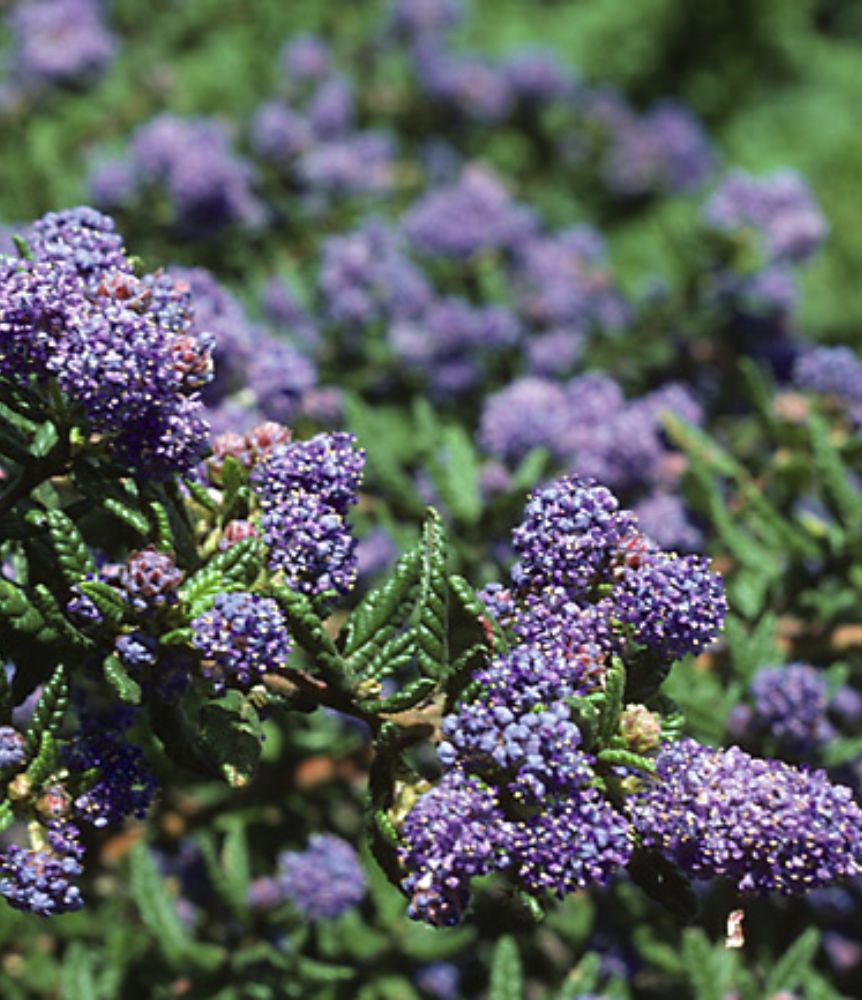
Far Horizons California lilac (Ceanothus ‘Far Horizons’) is noted for its dense growth habit and distinct round clusters of deep-blue flowers that appear in late winter. A dependable, medium-sized shrub and consistent early bloomer, it was originally selected by Santa Barbara Botanic Garden’s first horticulturist and plant breeder, Dara E. Emery. (Photo: Steven Timbrook)
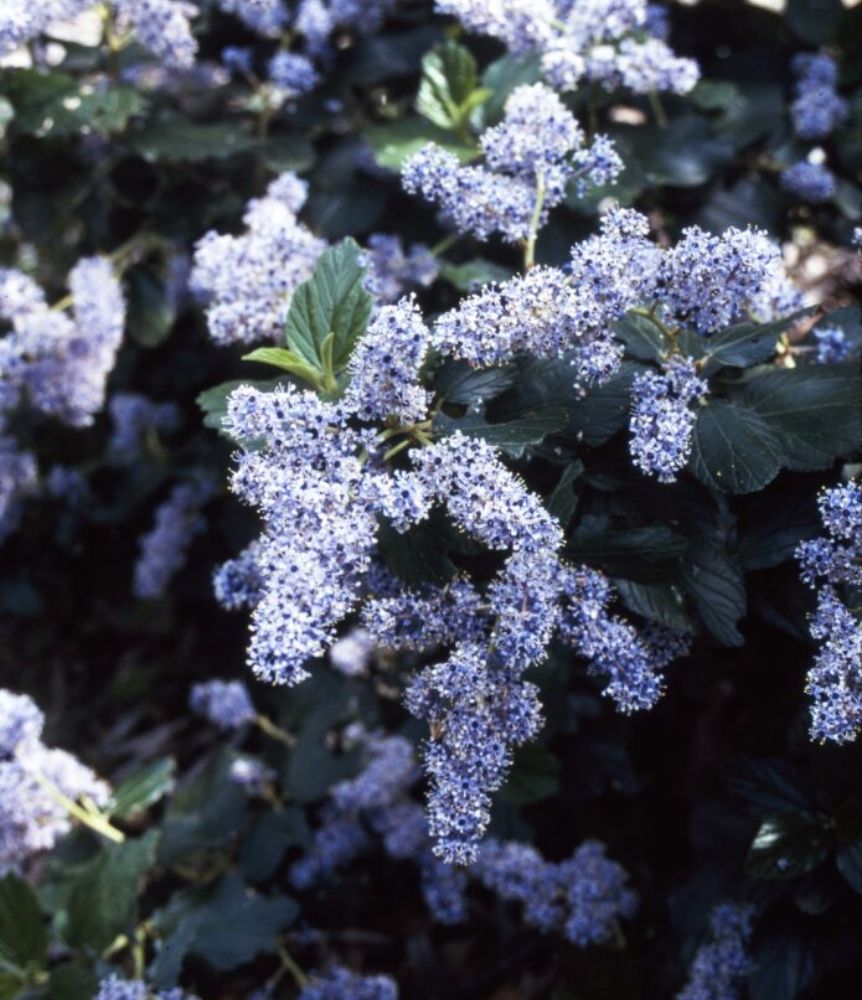
Powder Blue felt-leaf ceanothus (Ceanothus arboreus ‘Powder Blue’) is a medium-sized shrub featuring clusters of pale blue flowers and the large leaves typical of this Channel Islands species. This selection generally blooms earlier than other blueblossoms.
It was originally selected by former Santa Barbara Botanic Garden Director of Horticulture Carol Bornstein from an atypically low-growing individual on Santa Cruz Island. (Photo: Carol Bornstein)

Silver Lining desert lavender (Condea emoryi ‘Silver Lining’) is an upright, drought-tolerant desert shrub. Soft, fuzzy leaves are silver in color and exceptionally fragrant. Blue-violet flowers are born in small but numerous woolly clusters.
Silver Lining desert lavender was originally selected from the wild by former Santa Barbara Botanic Garden’s Director of Horticulture Carol Bornstein for its particularly silvery foliage. It was formerly known as Hyptis emoryi ‘Silver Lining.’ (Photo: Greg Trainor)
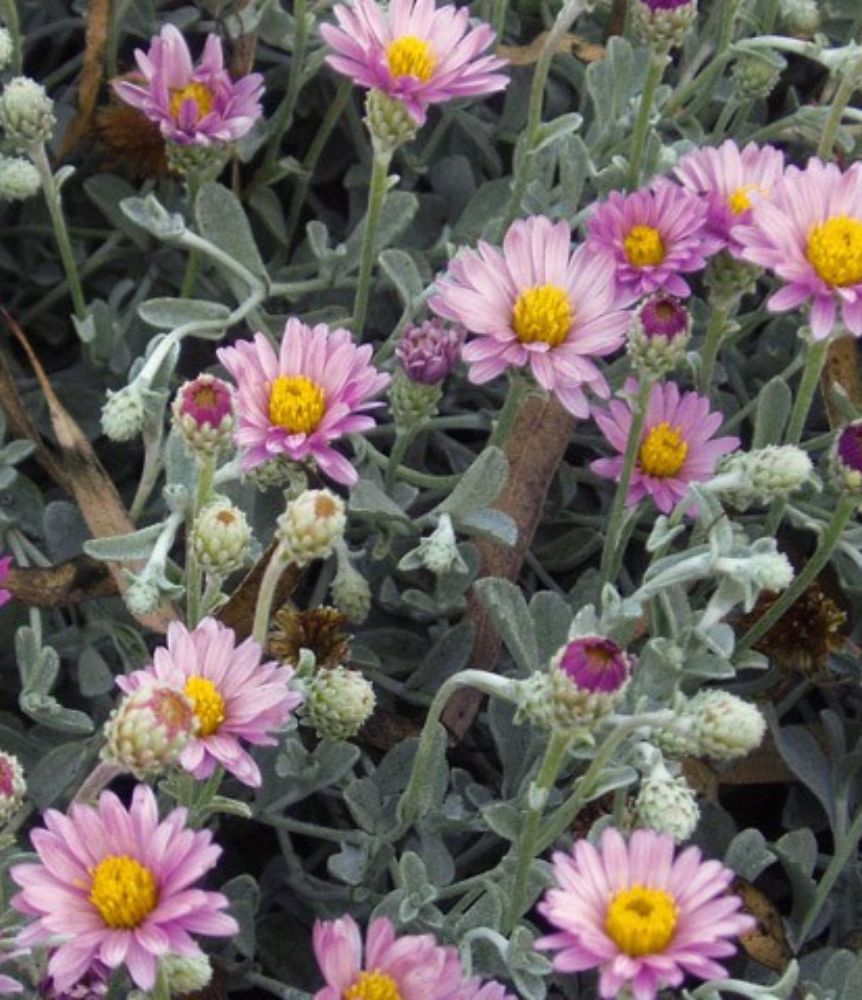
Silver Carpet aster (Corethrogyne filaginifolia ‘Silver Carpet’) is a low, dense, trailing perennial with soft hairy foliage that creates a silver appearance. Many pale lavender flowers appear in late summer. Its foliage blends well with other plants, and its summer blossoms provide a cool-toned color to the garden’s palette.
This plant was originally selected by former Santa Barbara Botanic Garden Director of Horticulture Carol Bornstein from coastal bluffs exposed to ocean spray in Monterey County. It is formerly known as Lessingia filaginifolia ‘Silver Carpet.’ (Photo: Bruce Reed)
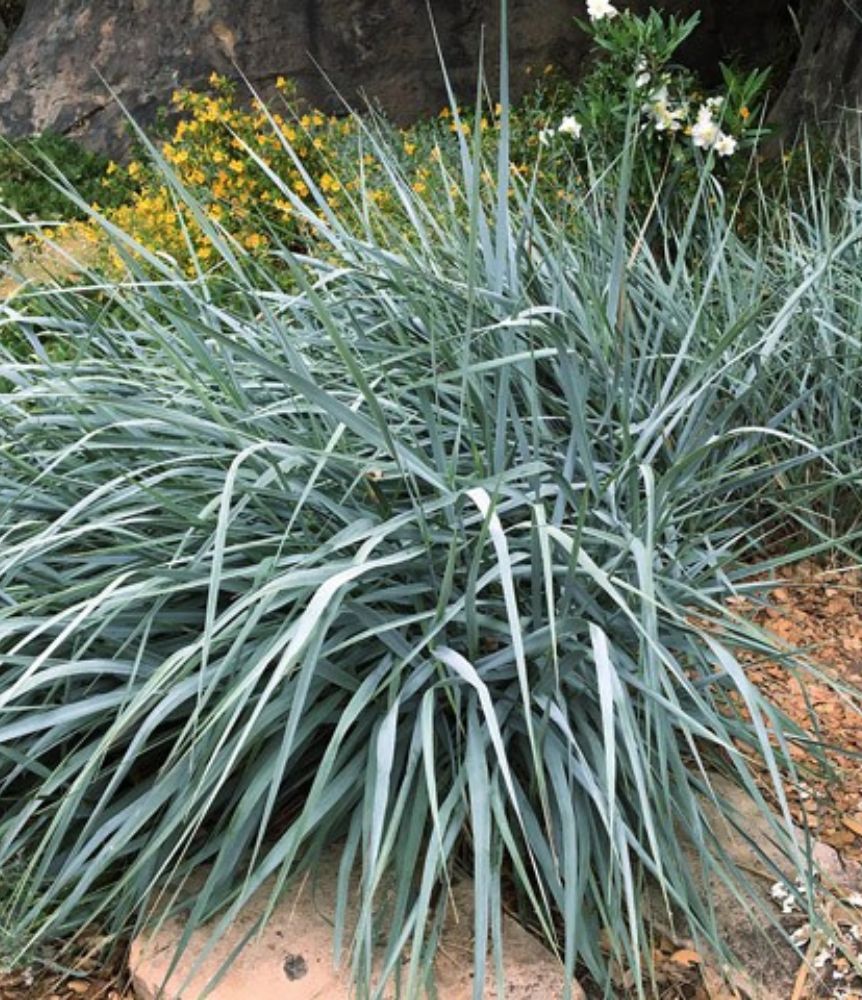
Large evergreen grass with striking blue-gray foliage defines Canyon Prince giant wild rye (Elymus condensatus ‘Canyon Prince’). One of the most popular and adaptable of California’s native grasses, this beautiful, drought-resistant selection is a great replacement for nonnative European dune grass (Elymus arenarius).
It originated from specimens collected by former Santa Barbara Botanic Garden Director Ralph Philbrick, Ph.D., on Prince Island, a small islet off San Miguel Island in the Santa Barbara Channel. The selection was made by Santa Barbara Botanic Garden’s first horticulturist and plant breeder, Dara E. Emery. This plant is formerly known as Leymus condensatus ‘Canyon Prince.’ (Photo: Betsy Collins)
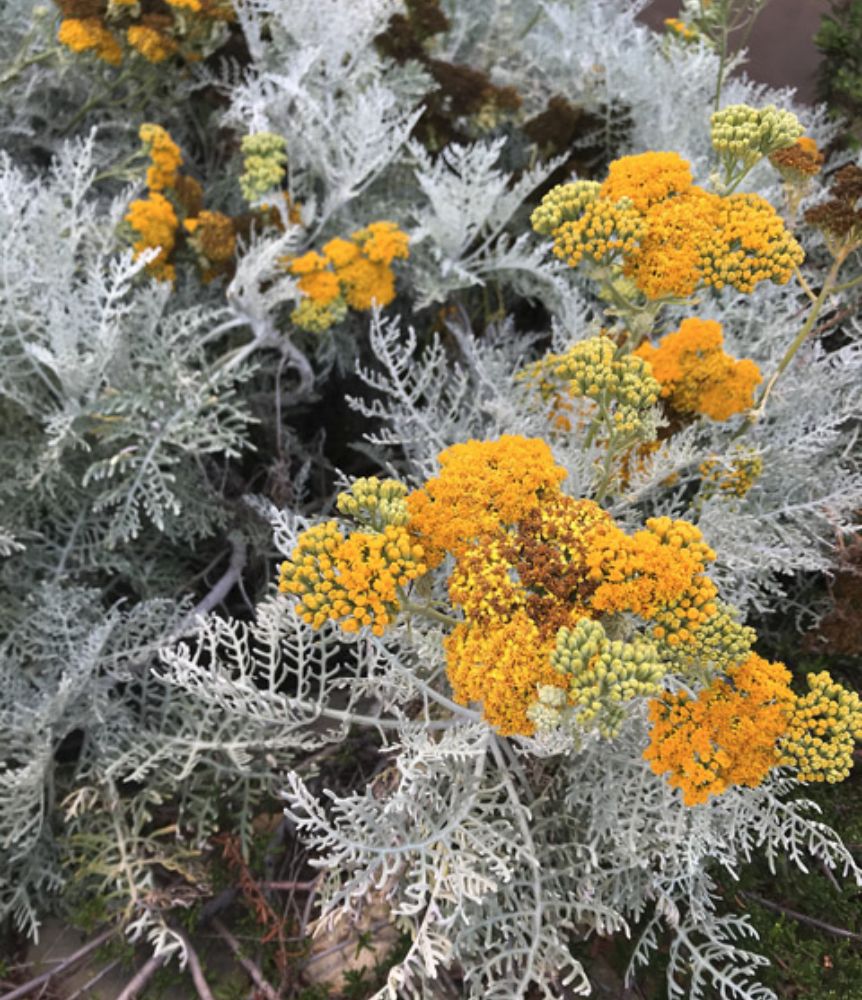
Distinguished by its deeply divided, lacy silver foliage, Canyon Silver Catalina silverlace (Constancea nevinii ‘Canyon Silver’) yields rich yellow blossoms in summer that turn chocolate brown in fall. With handsome foliage year-round, this perennial provides dramatic interest to any garden.
This plant was originally selected by former Santa Barbara Botanic Garden Director of Horticulture Carol Bornstein from a plant growing at the Garden. It is formerly known as Eriophyllum nevinii ‘Canyon Silver.’ (Photo: Carol Bornstein)
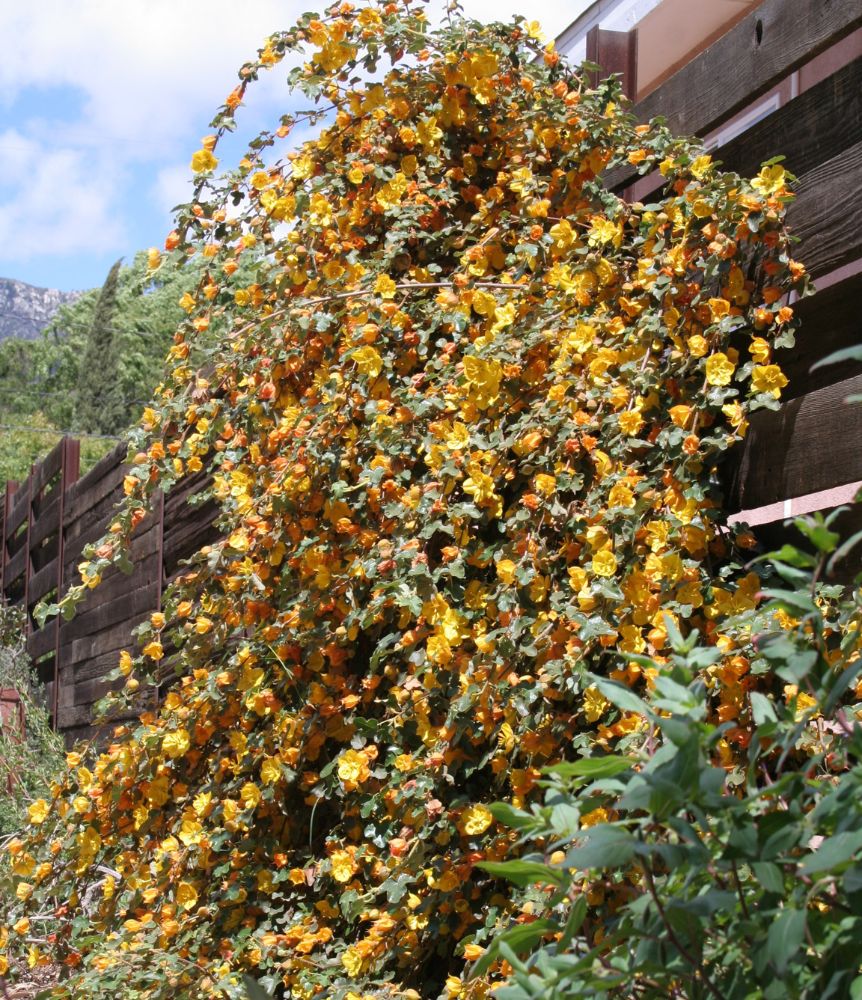
Dara’s Gold flannelbush (Fremontodendron ‘Dara’s Gold’) is an unusual low-mounding-growth form of flannelbush. The combination of shiny green foliage and bright yellow flowers distinguish Dara’s Gold for other low-growing cultivars. The long blooming season makes this selection particularly desirable.
This plant is a hybrid developed by Santa Barbara Botanic Garden’s first horticulturist and plant breeder, Dara E. Emery. Note the plant in this photo has been loosely espaliered on the wall. (Photo: Carol Bornstein)
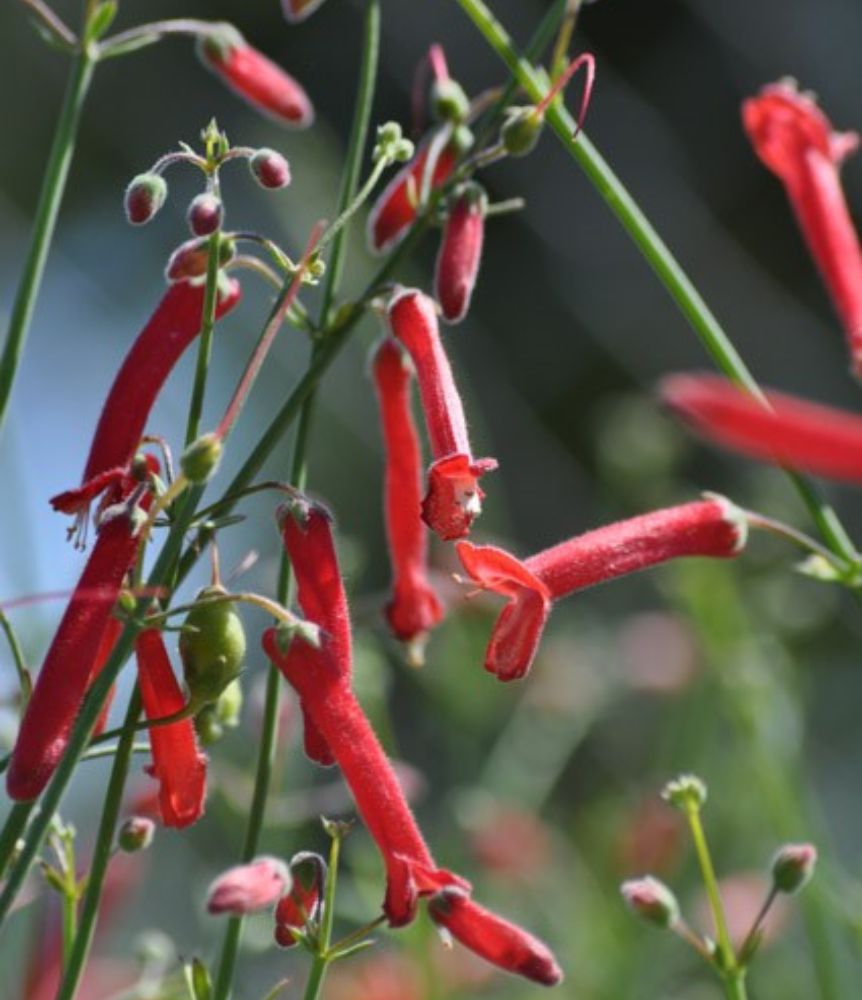
Gran Canon Baja bush snapdragon (Gambelia juncea ‘Gran Canon’) is a generally upright evergreen shrub with numerous, rush-like stems that bear long, tubular red flowers in spring and summer. Hummingbirds belove their distinctive red flowers. Low-growing stems may take root and help the plant to spread. Complements bold forms or spiny succulents in the garden.
This plant was originally selected by Santa Barbara Botanic Garden’s Director of Horticulture Carol Bornstein from an especially floriferous specimen on Cedros Island off the west coast of Baja California, Mexico. It is formerly known as Galvezia juncea ‘Gran Canon.’ (Photo: Heather Wehnau)
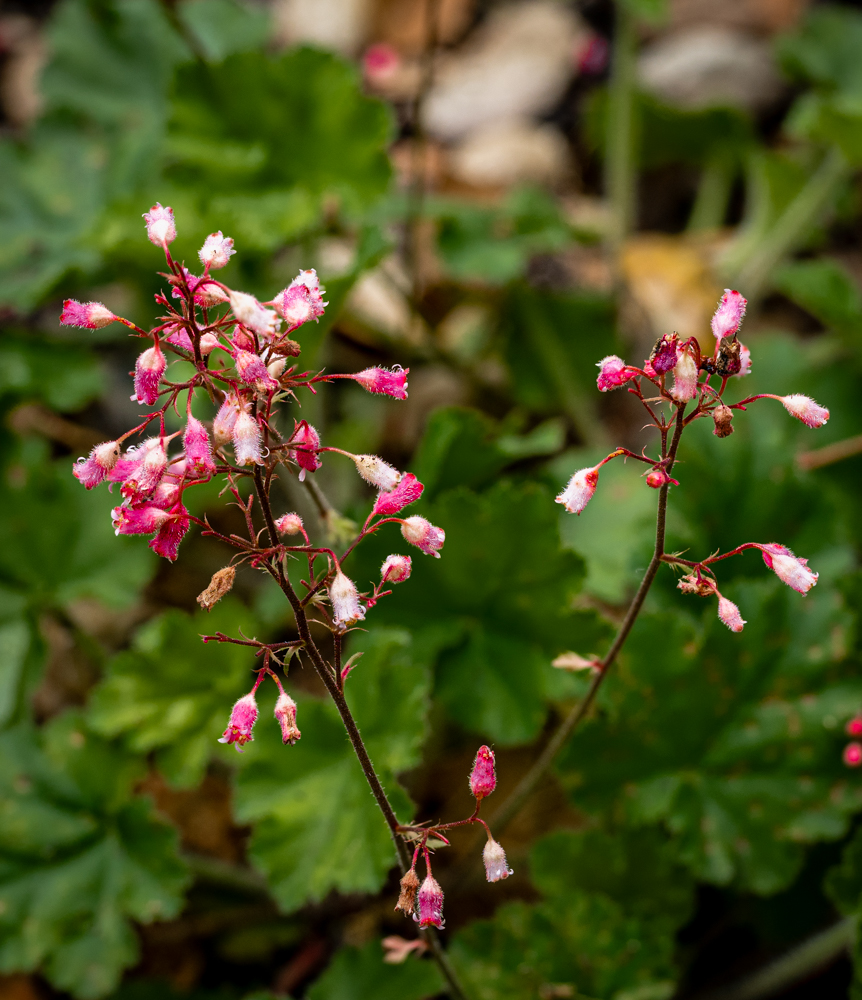
Blushing Bells coral bells (Heuchera ‘Blushing Bells’) forms a compact mat of rosettes with small, dark-green leaves. In spring, it is covered in drifts of small, white or pale-pink flowers.
This cultivar is a hybrid developed by Santa Barbara Botanic Garden’s first horticulturist and plant breeder, Dara E. Emery (Photo: Greg Trainor)
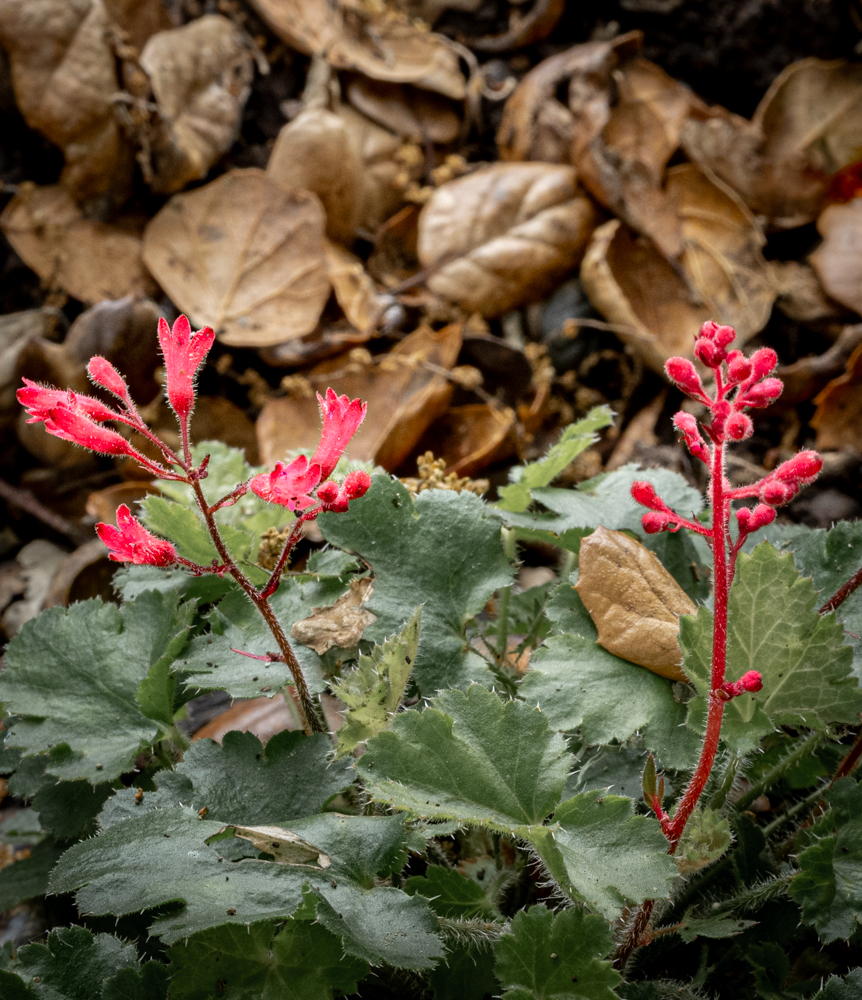
Canyon Belle coral bells (Heuchera ‘Canyon Belle’) is a compact, herbaceous perennial, which forms rosettes of dark-green, glossy leaves. In springtime, it creates a display of very showy bright red flowers.
This cultivar is a hybrid developed by Santa Barbara Botanic Garden’s first horticulturist and plant breeder, Dara E. Emery. (Photo: Greg Trainor)
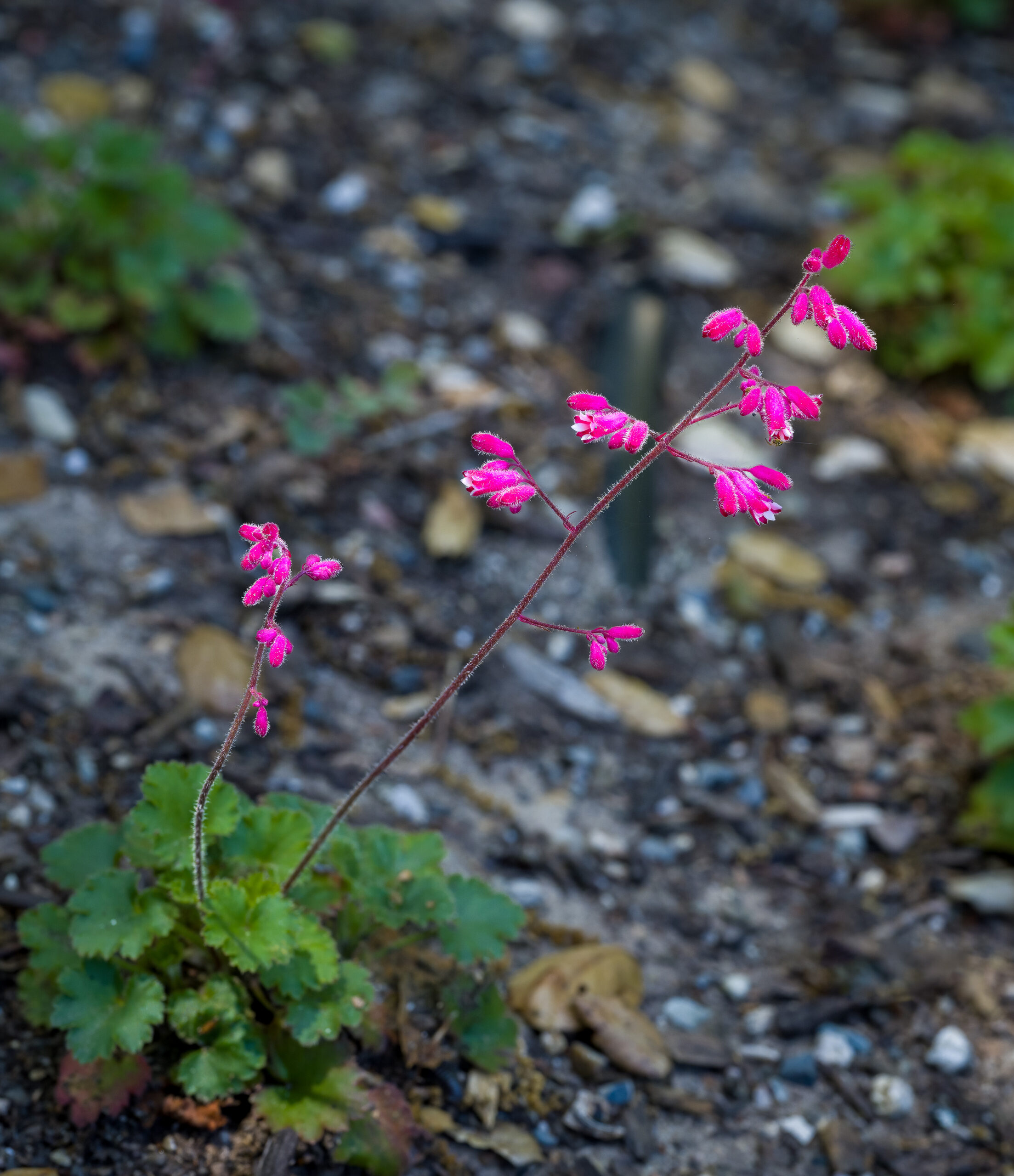
Canyon Chimes coral bells (Heuchera ‘Canyon Chimes’) is an evergreen, compact, mat-like herbaceous perennial. It’s a very reliable coral bell with dark pink flowers that continue over a long period in spring.
This cultivar is a hybrid developed by Santa Barbara Botanic Garden’s first horticulturist and plant breeder, Dara E. Emery. (Photo: Greg Trainor)
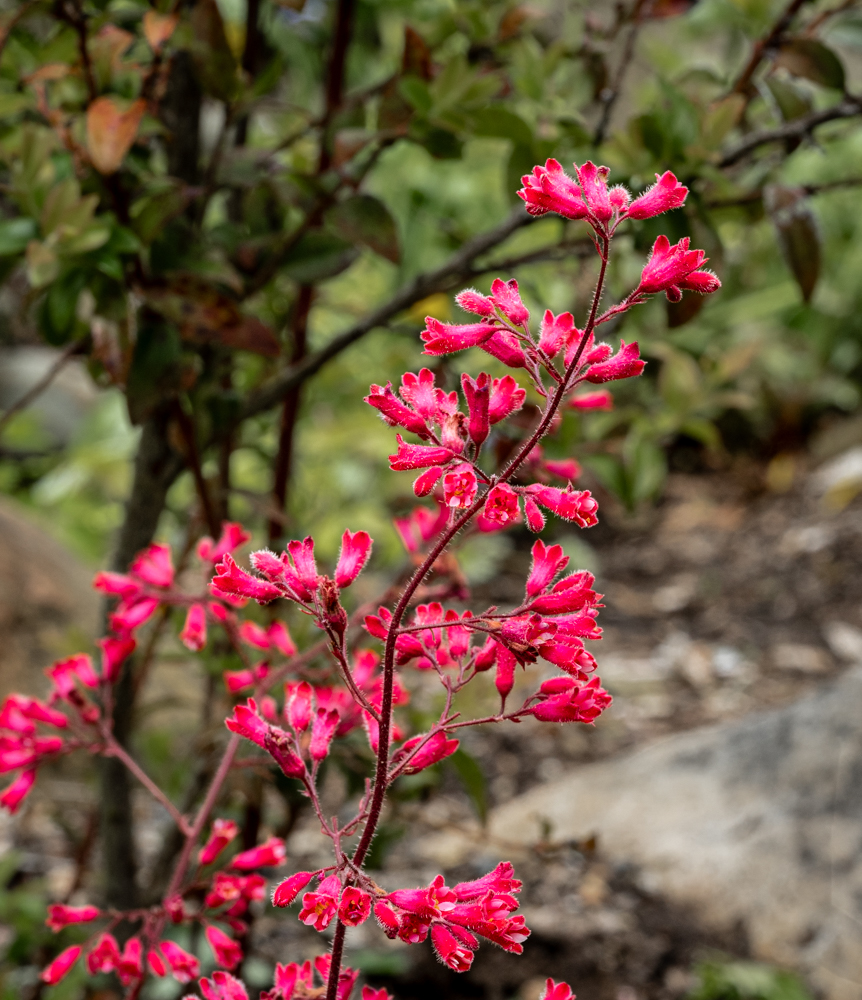
Canyon Delight coral bells (Heuchera ‘Canyon Delight’) is an herbaceous, evergreen perennial. The wide, medium-green leaves are topped by rosy-red flowers in spring. One of the best medium-sized coral bells, it is easy and long-lived.
This cultivar is a hybrid developed by Santa Barbara Botanic Garden’s first horticulturist and plant breeder, Dara E. Emery. (Photo: Greg Trainor)
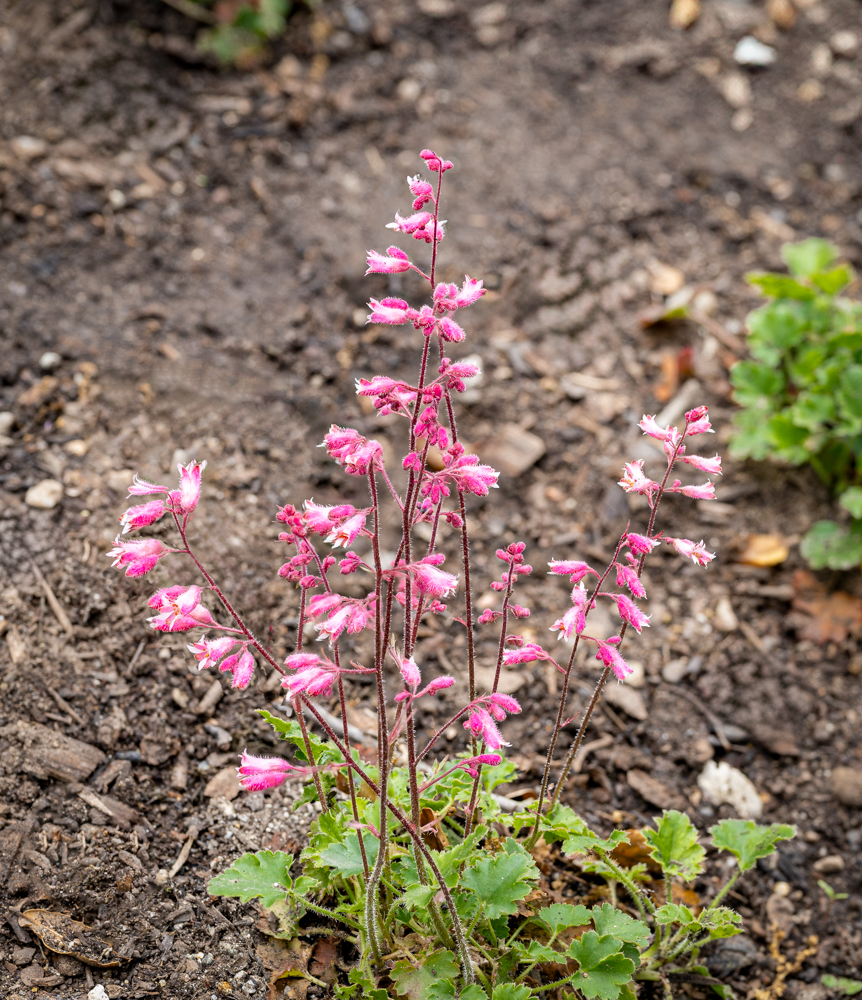
Canyon Duet coral bells (Heuchera ‘Canyon Duet’) is an evergreen, compact, mat-like herbaceous perennial. It has showy blooms with contrasting dark-pink and white flowers, hence the duet reference. Canyon Duet coral bells is a charming, diminutive, sturdy cultivar with distinctive flowers.
This cultivar is a hybrid developed by Santa Barbara Botanic Garden’s first horticulturist and plant breeder, Dara E. Emery. (Photo: Greg Trainor)
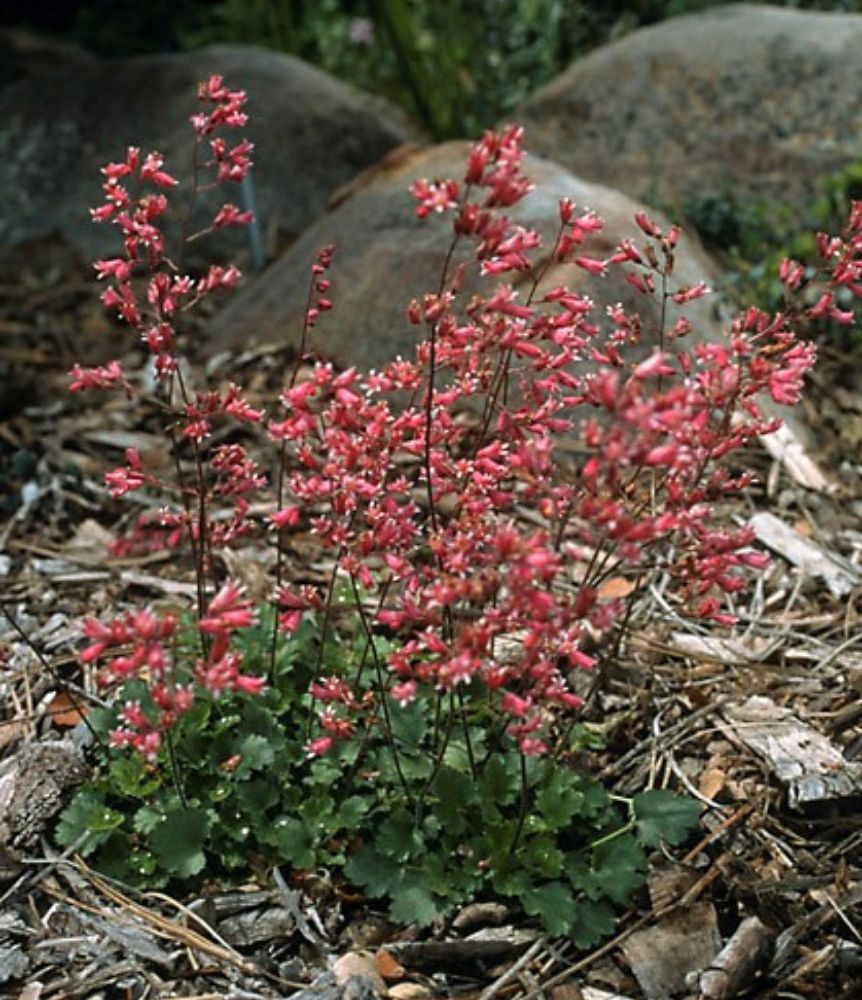
Canyon Melody coral bells (Heuchera ‘Canyon Melody’) is an evergreen, compact, mat-like herbaceous perennial with a profusion of medium-pink flowers with white highlights.
This cultivar is a hybrid developed by Santa Barbara Botanic Garden’s first horticulturist and plant breeder, Dara E. Emery. (Photo: Carol Bornstein)
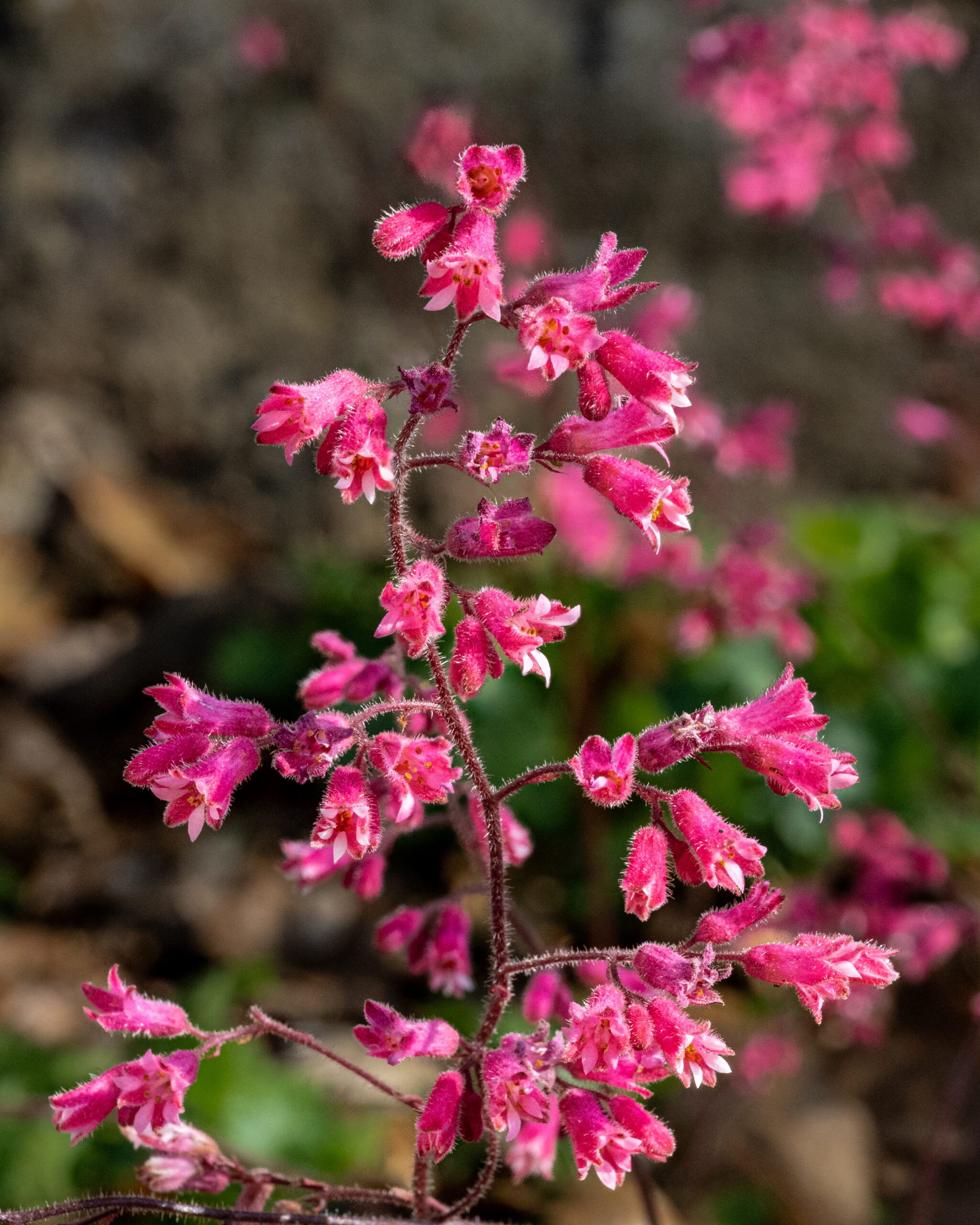
Canyon Pink coral bells (Heuchera ‘Canyon Pink’) is an herbaceous, evergreen perennial with a low, compact growth form. Deep-pink flowers appear in spring. It is easy to grow and long-lived.
This cultivar is a hybrid developed by Santa Barbara Botanic Garden’s first horticulturist and plant breeder, Dara E. Emery. (Photo: Greg Trainor)
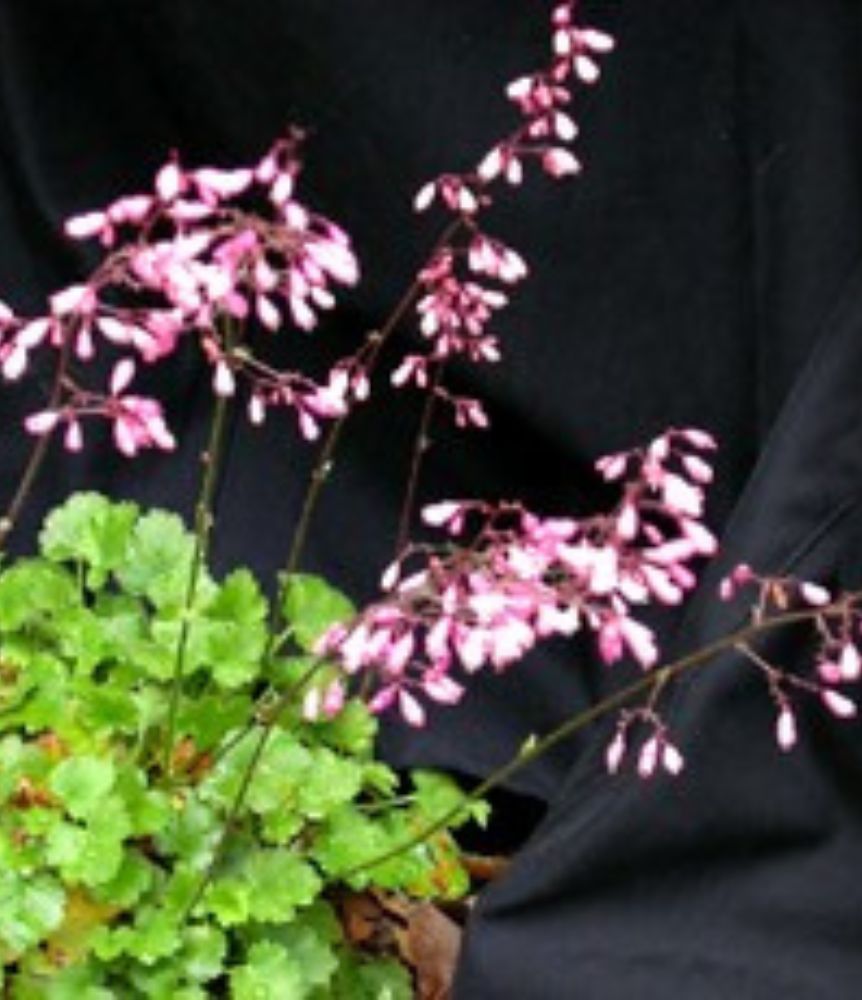
Dainty Bells coral bells (Heuchera ‘Dainty Bells’) is an herbaceous, evergreen, compact perennial. Inflorescences of small rose-pink to rose-red flowers bloom in spring.
This cultivar is a hybrid developed by Santa Barbara Botanic Garden’s first horticulturist and plant breeder, Dara E. Emery.
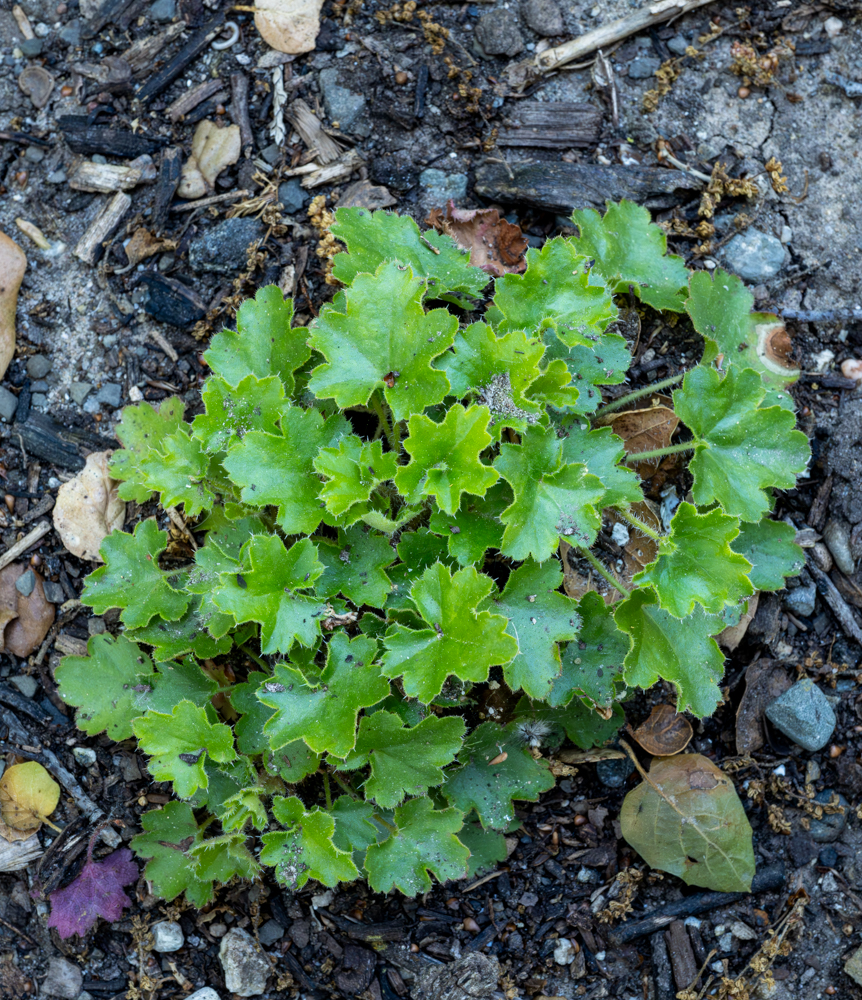
Pink Wave coral bells (Heuchera ‘Pink Wave’) is an herbaceous, evergreen perennial with an unusually dense, mat-like growth habit. Leaves are small and glossy with distinctive wavy margins and the springtime flowers are medium-pink.
This cultivar is a hybrid developed by Santa Barbara Botanic Garden’s first horticulturist and plant breeder, Dara E. Emery. (Photo: Greg Trainor)
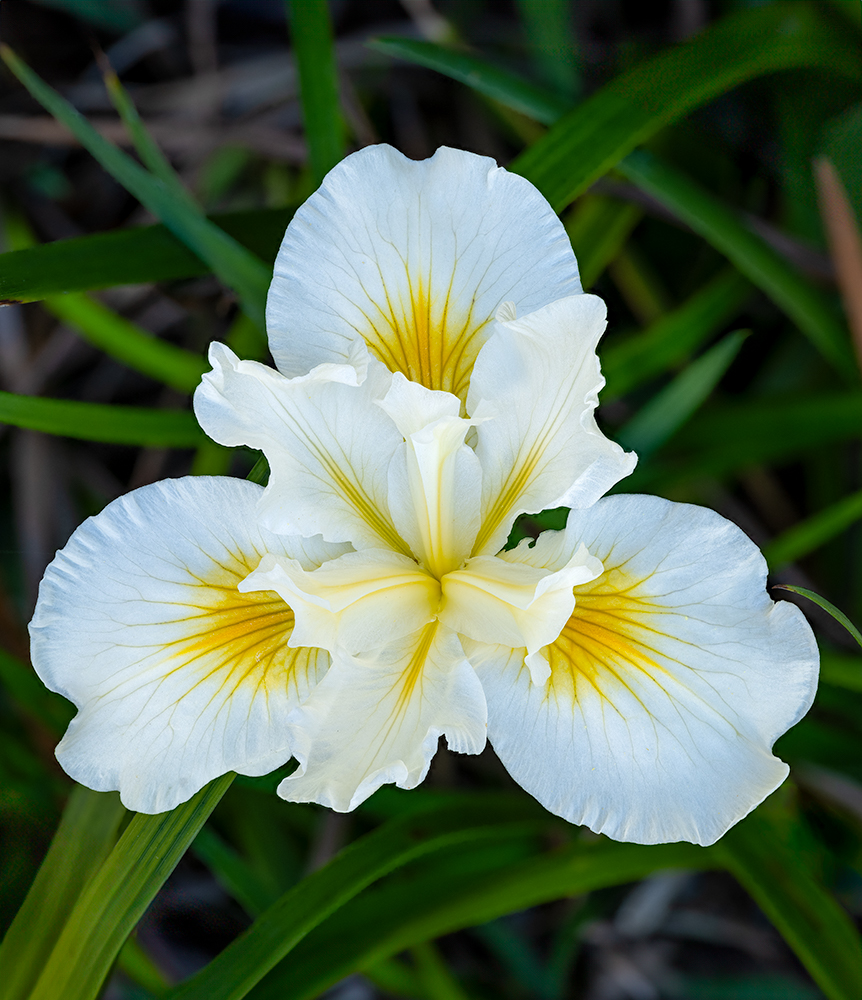
One of the loveliest of the Pacific Coast Hybrid irises, Canyon Snow iris (Iris ‘Canyon Snow’) has brilliant-white flowers that consist of three erect standards and three broad falls held perpendicular to the stem. Each fall is highlighted by a yellow patch at the base. This plant slowly spreads to form clumps up to 4-feet (1-meter) across and has shiny green leaves.
Selected by Santa Barbara Botanic Garden’s first horticulturist and plant breeder, Dara E. Emery. (Photo: Greg Trainor)
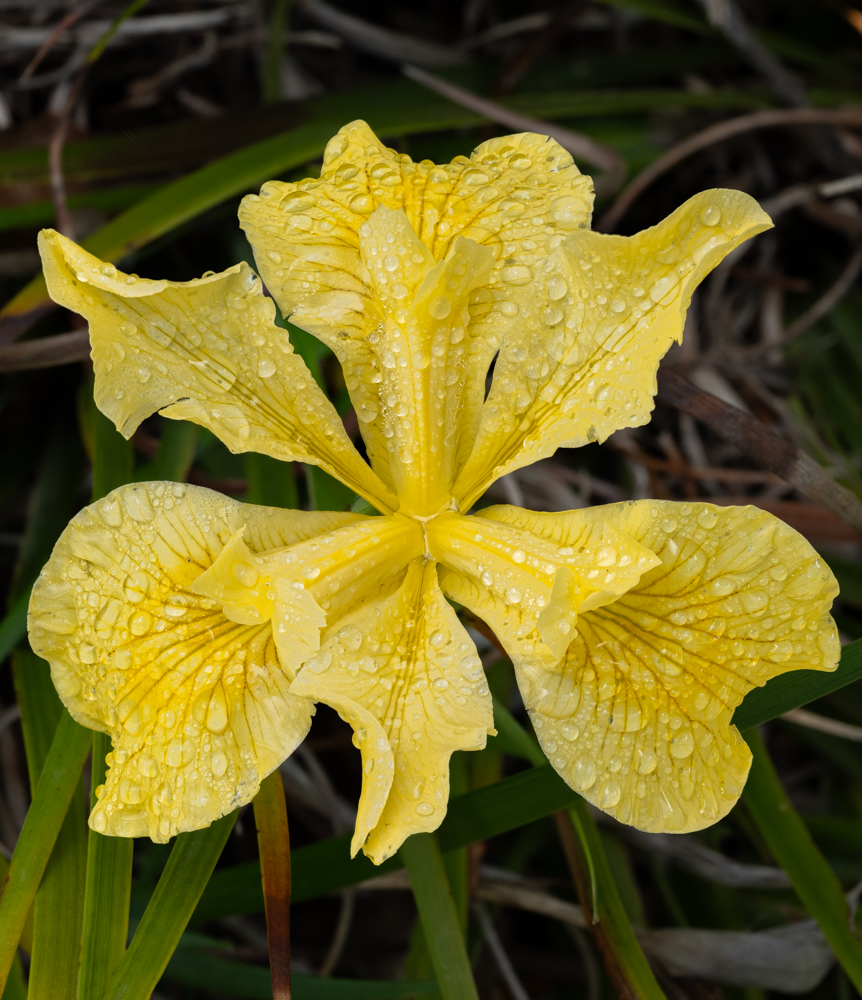
Canyon Sunshine pacifica iris (Iris ‘Canyon Sunshine’) blends the trouble-free longevity of Canyon Snow iris (Iris ‘Canyon Snow’) and the beautiful yellow of a now-lost cultivar, Canyon Gold iris (Iris ‘Canyon Gold’). Canyon Sunshine is a relatively large iris, selected by Santa Barbara Botanic Garden’s former Director of Horticulture Carol Bornstein from hybrid crosses made by the Garden’s first horticulturist and plant breeder, Dara E. Emery.
Canyon Sunshine was one of the last plant crosses to be selected for naming from Emery. (Photo: Greg Trainor)
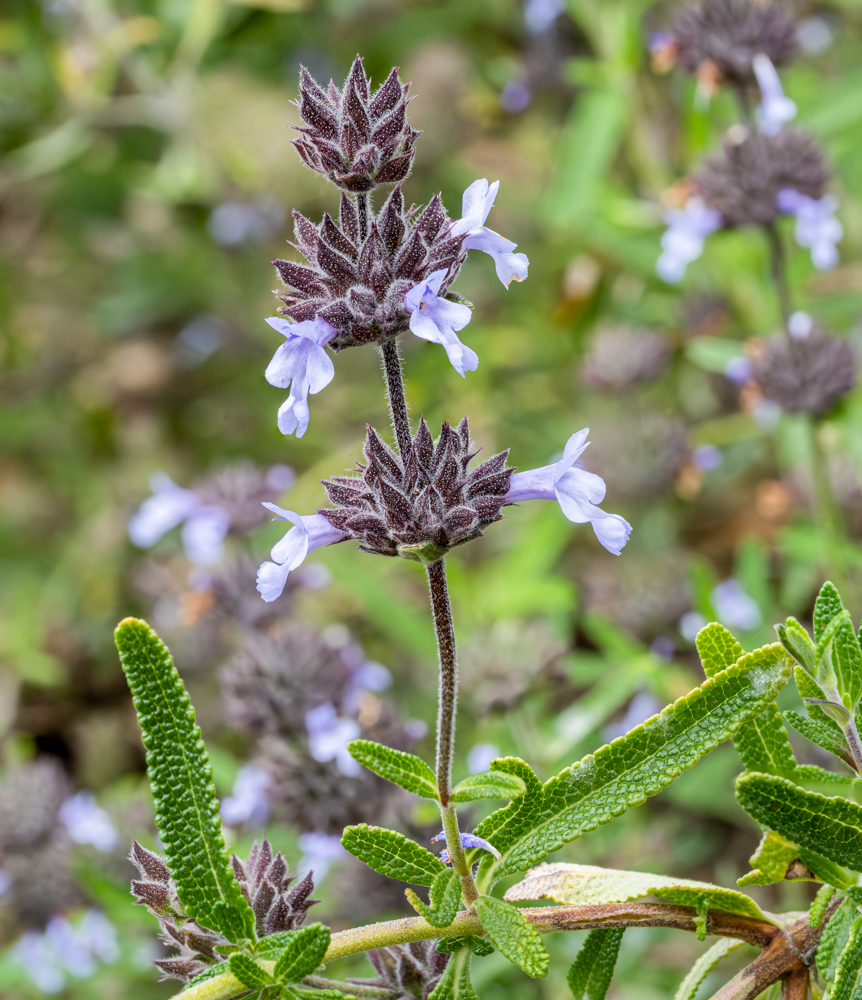
Pacific Blue sage (Salvia ‘Pacific Blue’) is a robust, fast-growing, aromatic native sage. The growth form is an upright, multi-stemmed shrub with arching branches. Aromatic, narrow green leaves have a pebbled texture. In late winter and spring, look for lots of purple-blue flowers.
Pacific Blue was originally selected by former Santa Barbara Botanic Garden Director of Horticulture Carol Bornstein from a plant growing in the Garden. It is reputably a hybrid of Salvia brandegeei and Salvia munzii. (Photo: Greg Trainor)
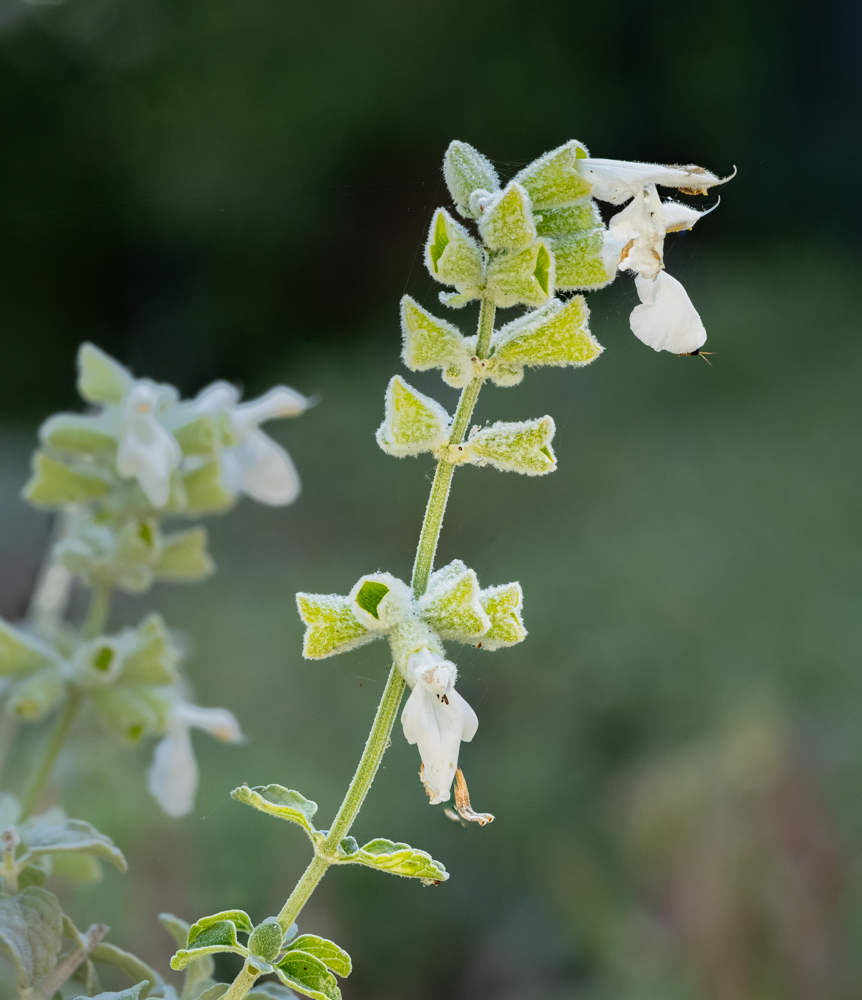
Baja Blanca Cedros Island sage (Salvia cedrosensis ‘Baja Blanca’) is a low, rounded subshrub. The white stems bear gray-green leaves and bright white flowers. This diminutive sage has a pleasing shape, copious flowers, and a long blooming season, especially when grown in a container.
Baja Blanca Cedros Island sage is a selection by Michael Benedict from Cedros Island, off the coast of Baja California, Mexico. (Photo: Greg Trainor)
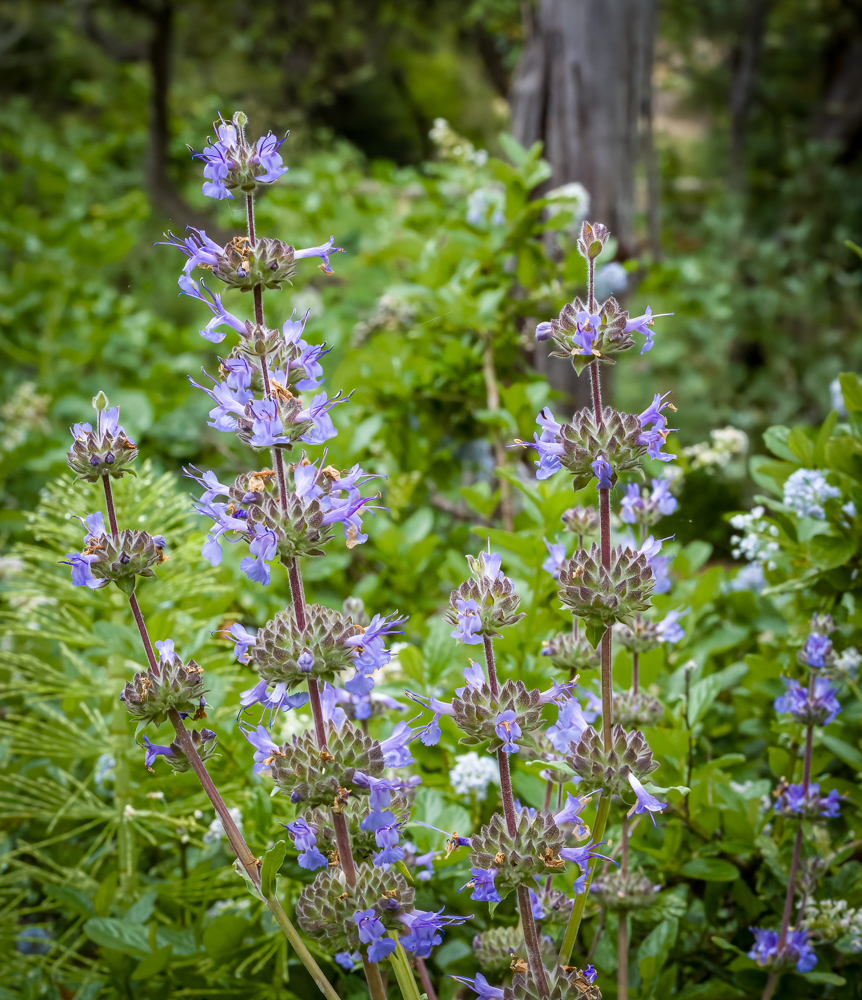
Dara’s Choice sage (Salvia ‘Dara’s Choice’) is an evergreen subshrub with a low-spreading growth habit. The leaves are medium green above, whitish green beneath, and highly aromatic. The blue-purple flowers appear in spring and attract hummingbirds.
This cultivar was selected from a crop of seedlings grown by Santa Barbara Botanic Garden’s first horticulturist and plant breeder, Dara E. Emery. (Photo: Greg Trainor)
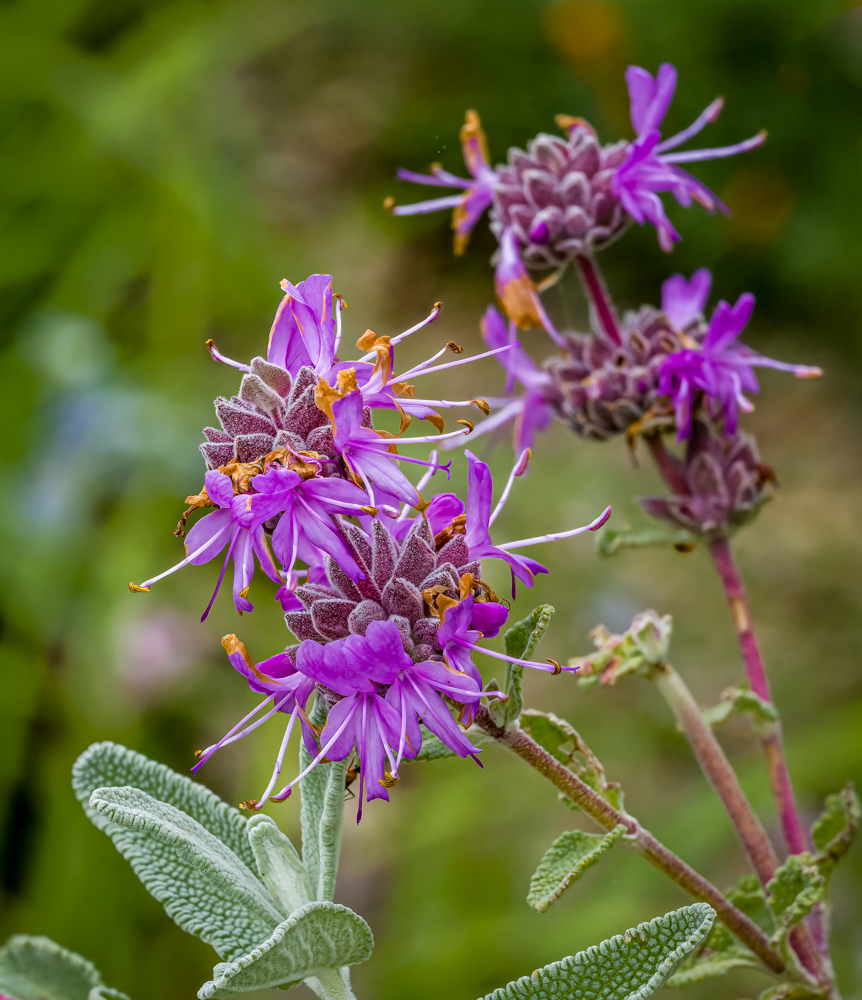
Starting out as a low-mounding shrub, Amethyst Bluff purple sage (Salvia leucophylla ‘Amethyst Bluff’) eventually reaches 5 feet (1.5 meters) in height and continues to spread outward. Large, vivid purple-pink flowers blossom in spring and summer and contrast nicely with the silvery foliage.
This is a selection of purple sage by former Santa Barbara Botanic Garden Director of Horticulture Carol Bornstein from the coastal bluffs of Point Sal in northern Santa Barbara County. (Photo: Greg Trainor)
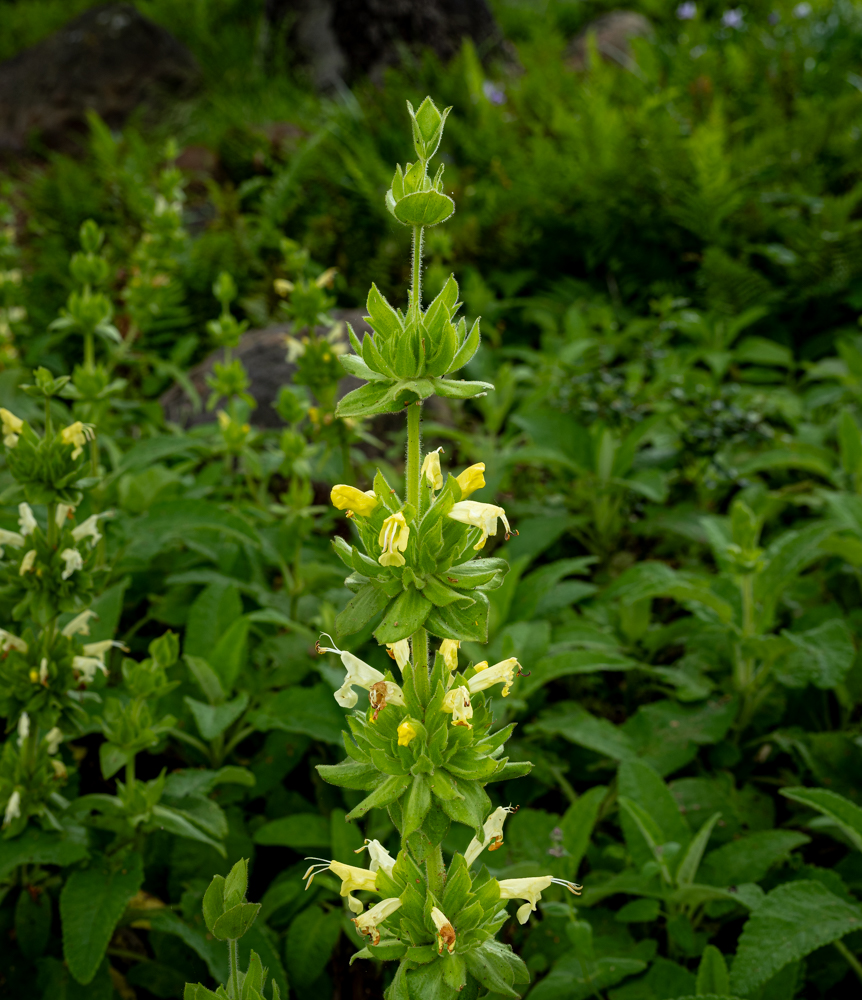
Avis Keedy hummingbird sage (Salvia spathacea ‘Avis Keedy’) is a herbaceous groundcover with long, wavy arrow-shaped leaves. This selection is distinguished by its lemon-yellow flowers with lime-green bracts that appear in late winter and early spring. The entire plant has a wonderful, fruity fragrance.
This selection was found in the wild by Avis Keedy, a long-time volunteer at Santa Barbara Botanic Garden, and named in her honor. (Photo: Greg Trainor)
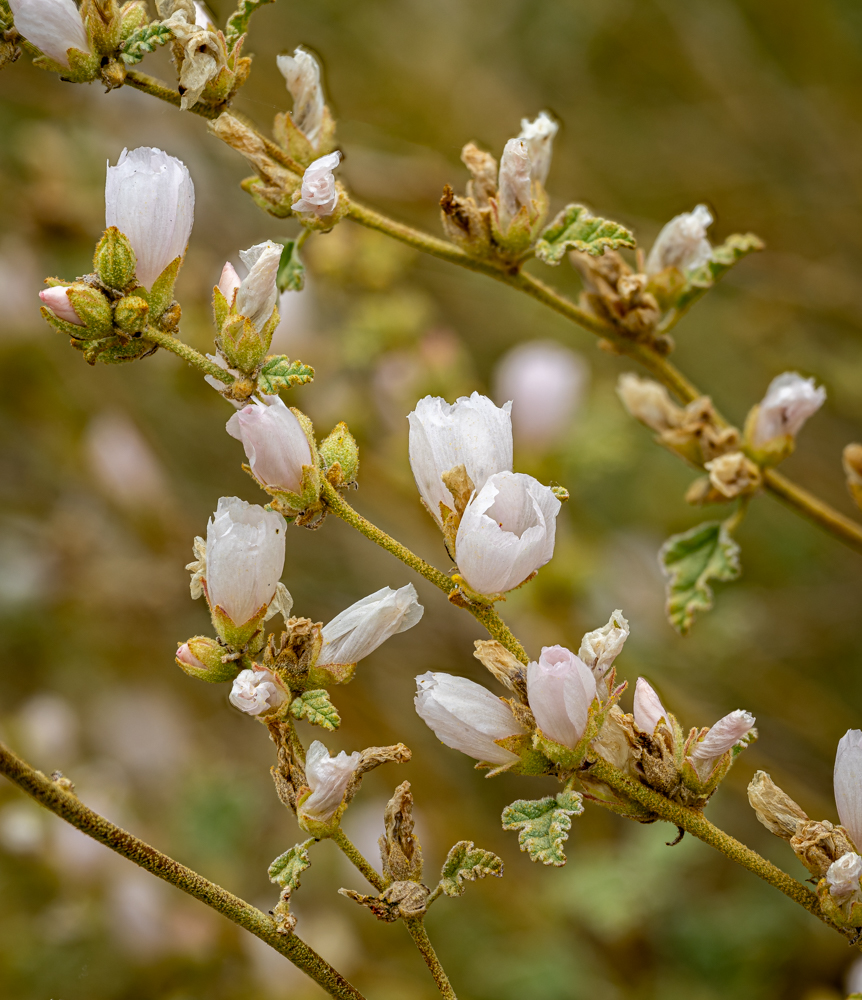
La Luna desert mallow (Sphaeralcea fulva ‘La Luna’) is a medium-sized, rounded evergreen shrub with sage-green, shallowly lobed leaves. The cup-shaped white flowers explode into bloom in the spring and summer. The copious, shimmering white blossoms, long blooming season, and unusual color combination of golden stems, gray-green leaves, and white flowers make this a fine addition to the dry garden.
This selection was made from the coastal desert scrub vegetation of northern Baja California, Mexico, by former Santa Barbara Botanic Garden Gardener Randy Mudge. (Photo: Greg Trainor)
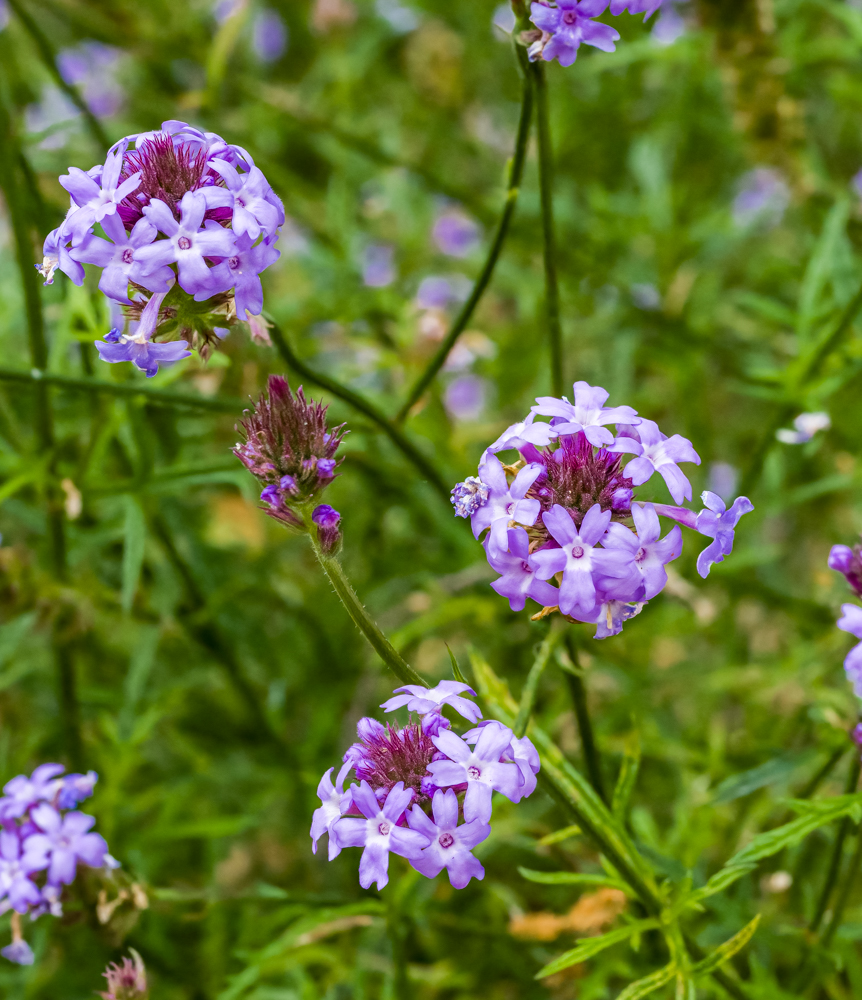
De La Mina lilac verbena (Verbena lilacina ‘De La Mina’) forms a tidy, handsome mound up to 3-feet (nearly 1-meter) high with an equal spread. It has deeply divided, medium-green leaves and dark-purple, fragrant flowers which bloom almost year-round in coastal California.
This plant was selected for its darker-than-usual flowers by former Santa Barbara Botanic Garden Director of Horticulture Carol Bornstein from Cedros Island off the west coast of Baja California, Mexico. (Photo: Greg Trainor)
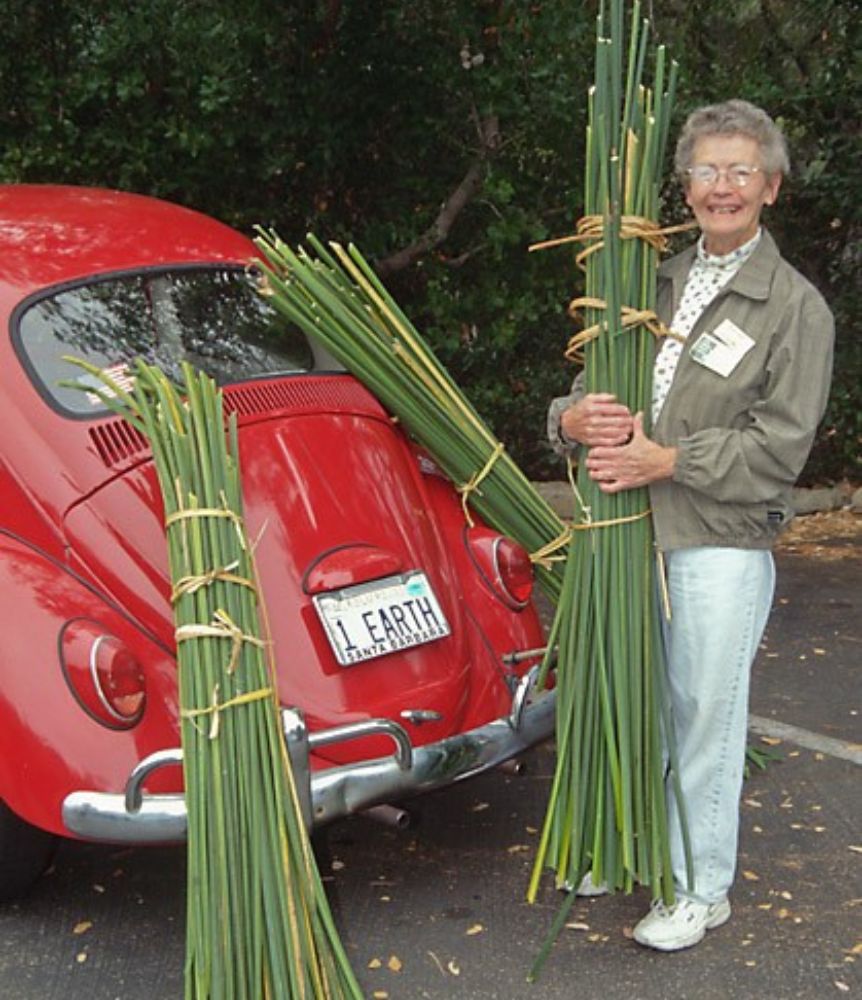
Designed brilliance
What Is a Cultivar?
Short for “cultivated variety,” a cultivar is a plant that has been selected by humans and propagated for its desirable traits. These traits could include larger flowers and fruits, atypical growth habits, unusual flower colors, disease resistance, and other unique features.
Cultivars can come from many sources and have been a part of gardening for almost as long as humans have grown plants. Some cultivars are the result of intentional plant breeding through hybridization, while others are naturally occurring seedlings with traits that make them stand out from the straight species.
Meet the Team
-
Living Collections Curator
-
Director of Horticulture and Operations
-
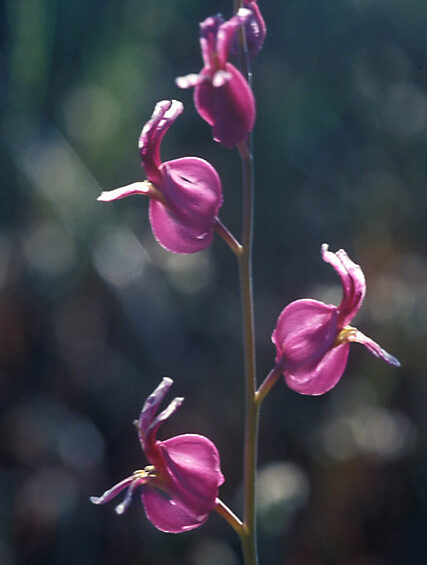 Nel NolanPropagator
Nel NolanPropagator -
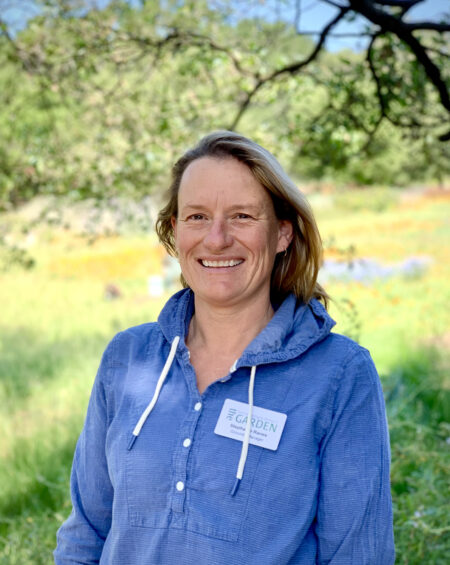 Stephanie RanesGrounds Manager
Stephanie RanesGrounds Manager
 Donate
Donate